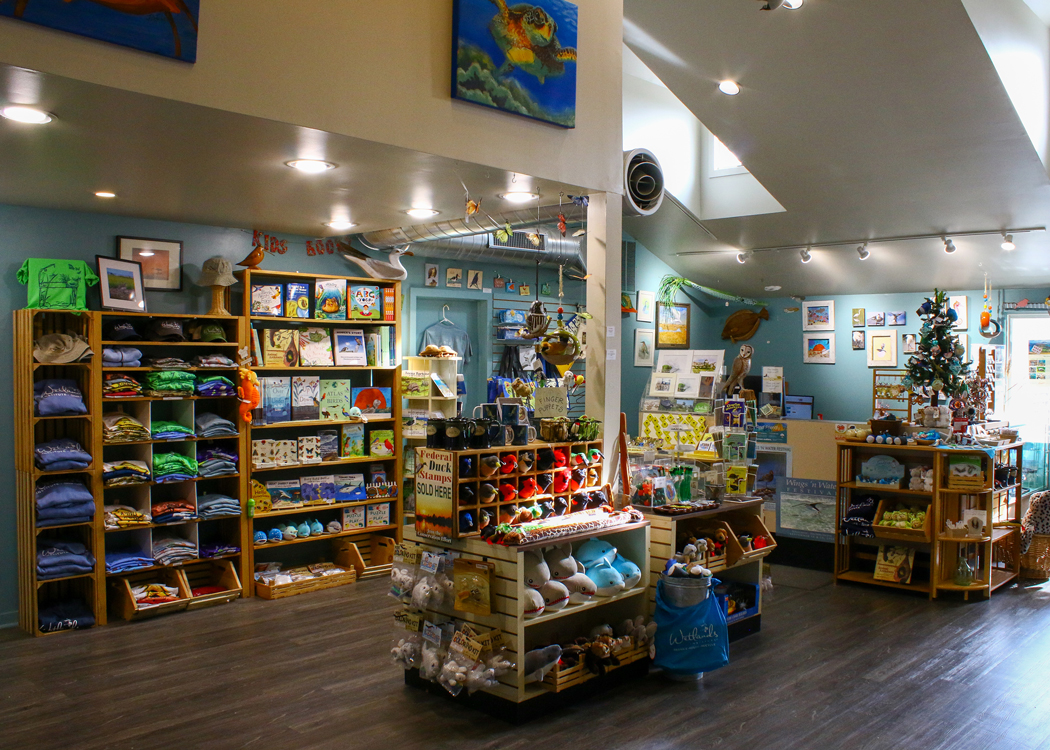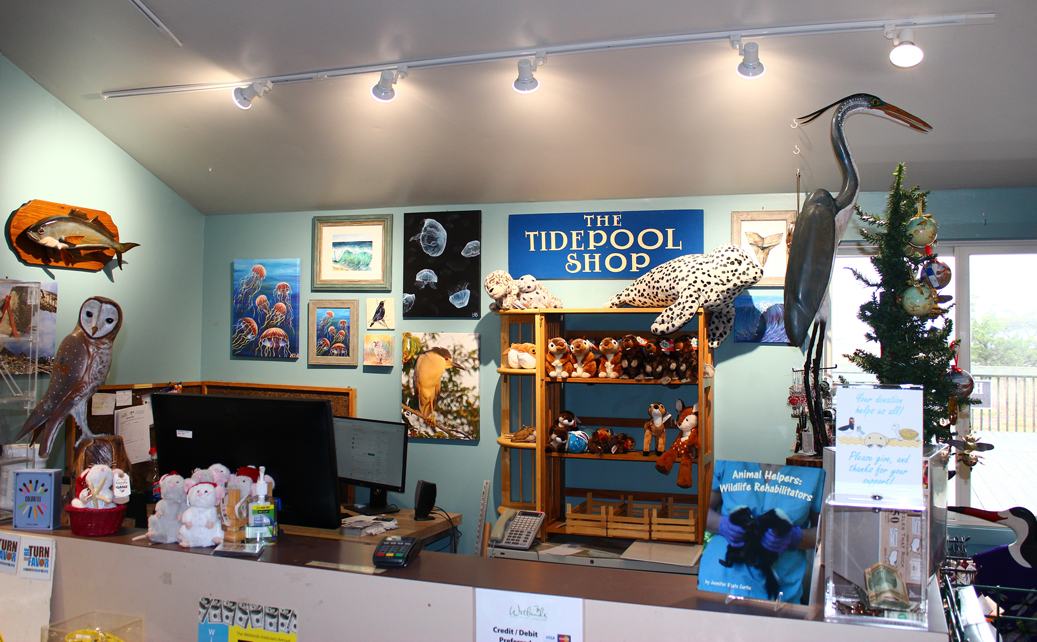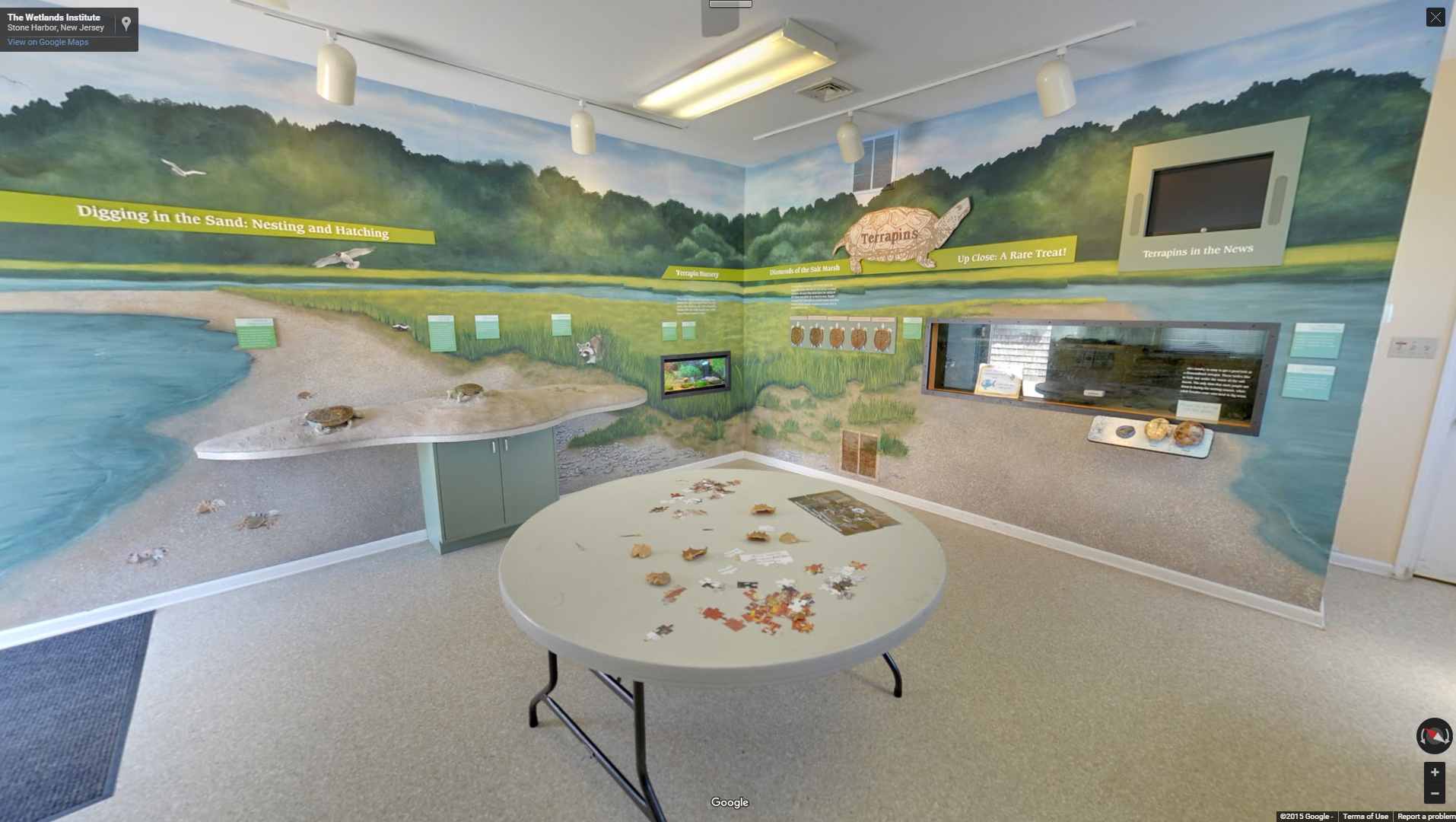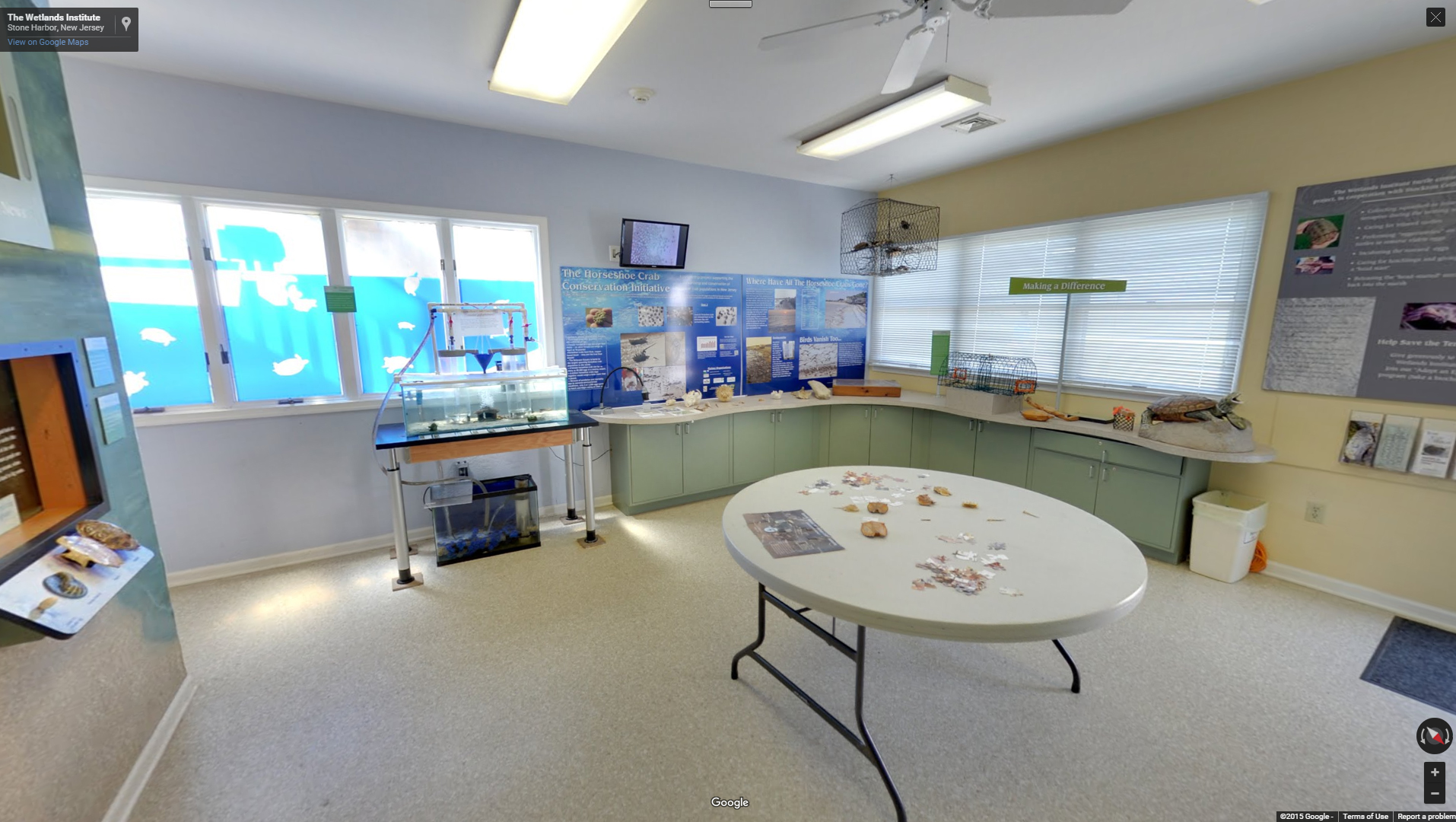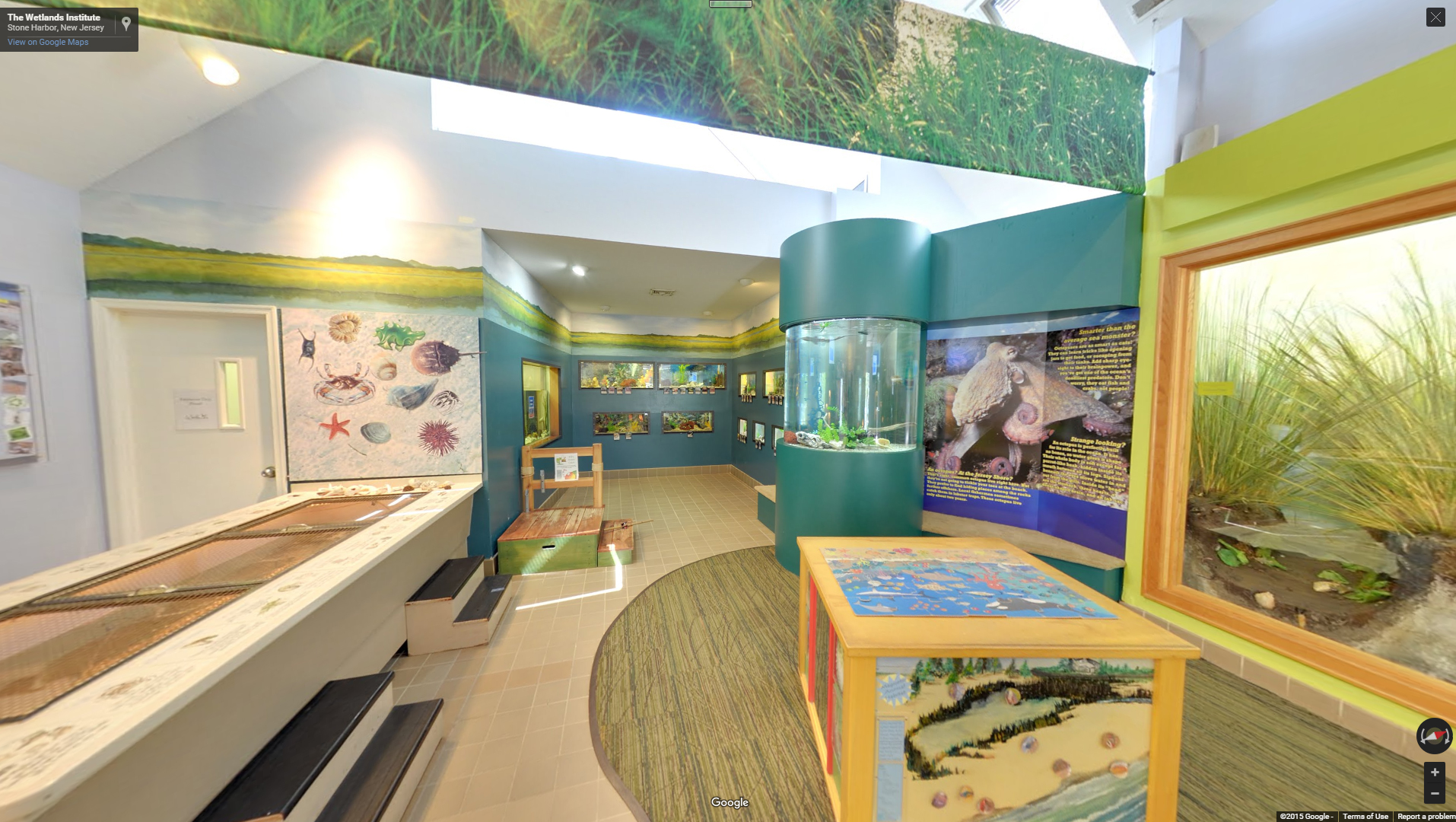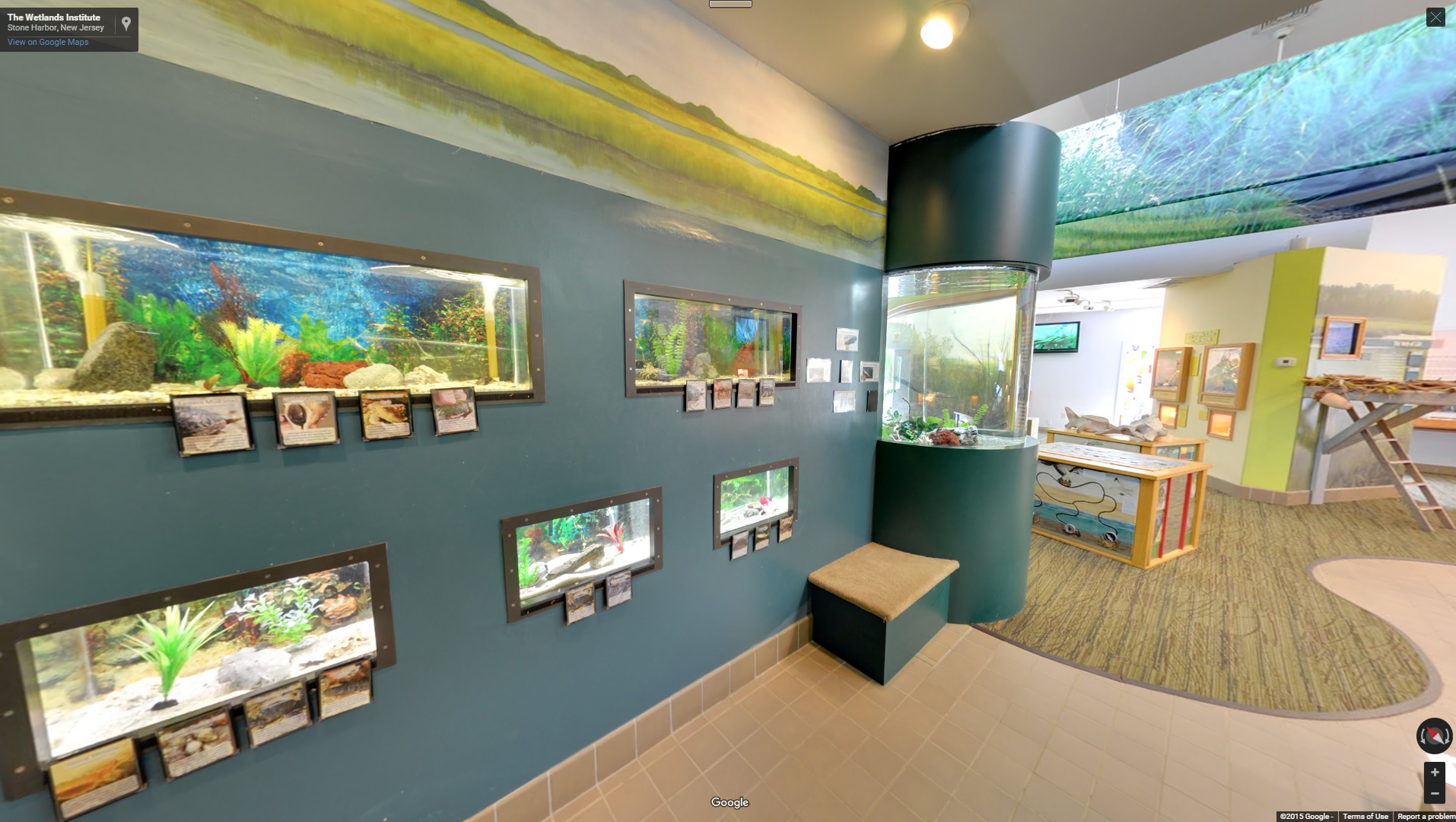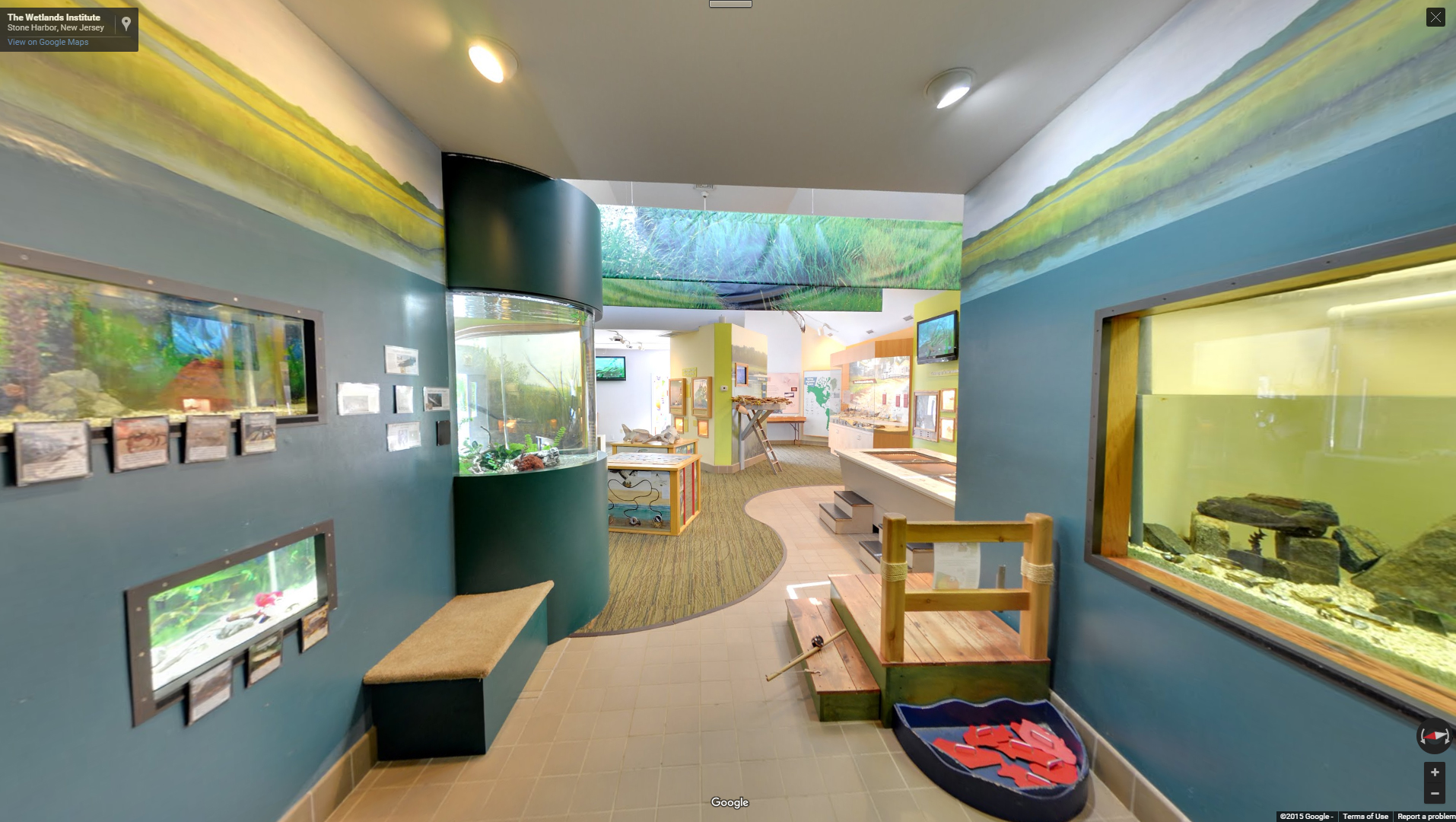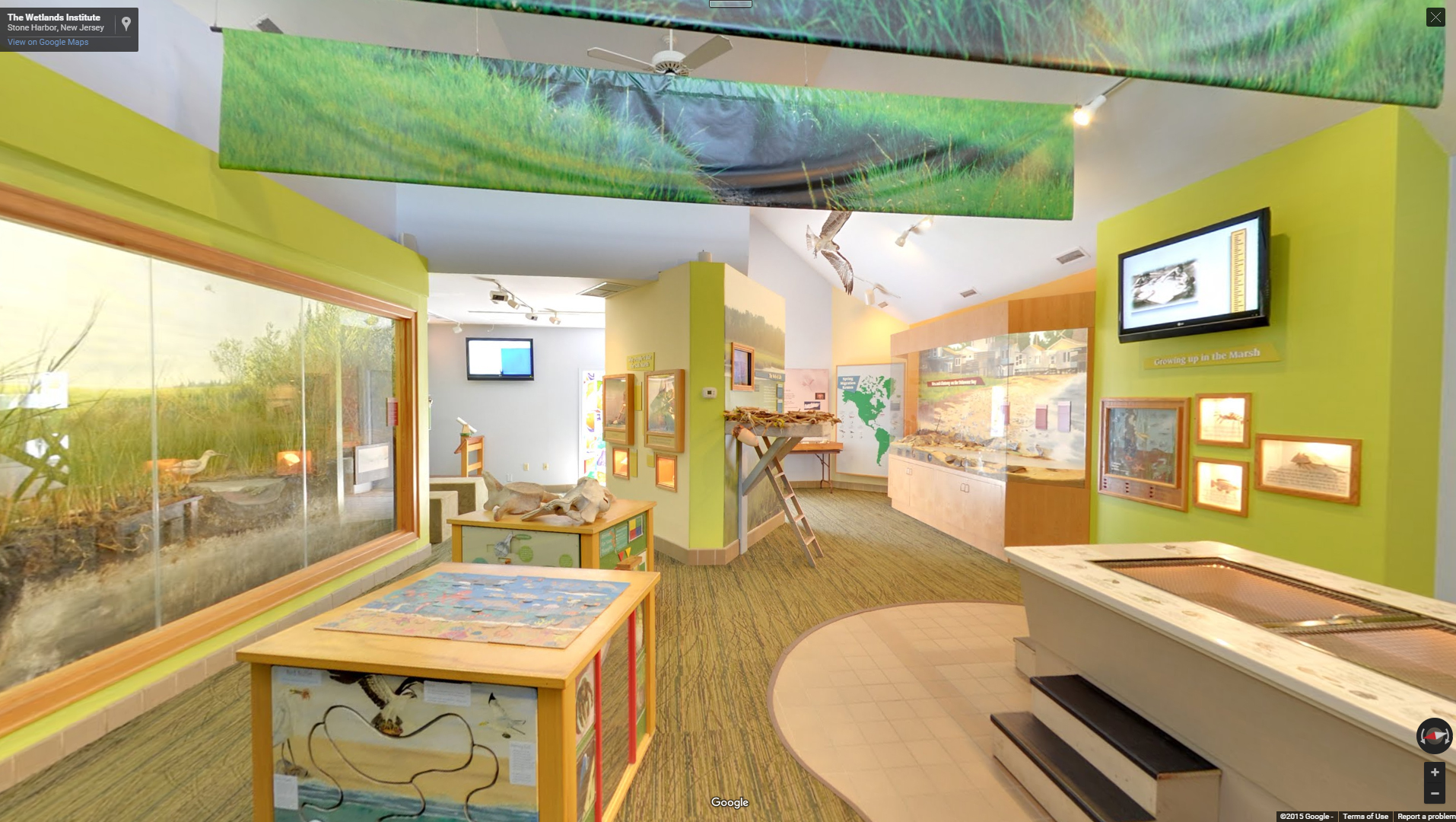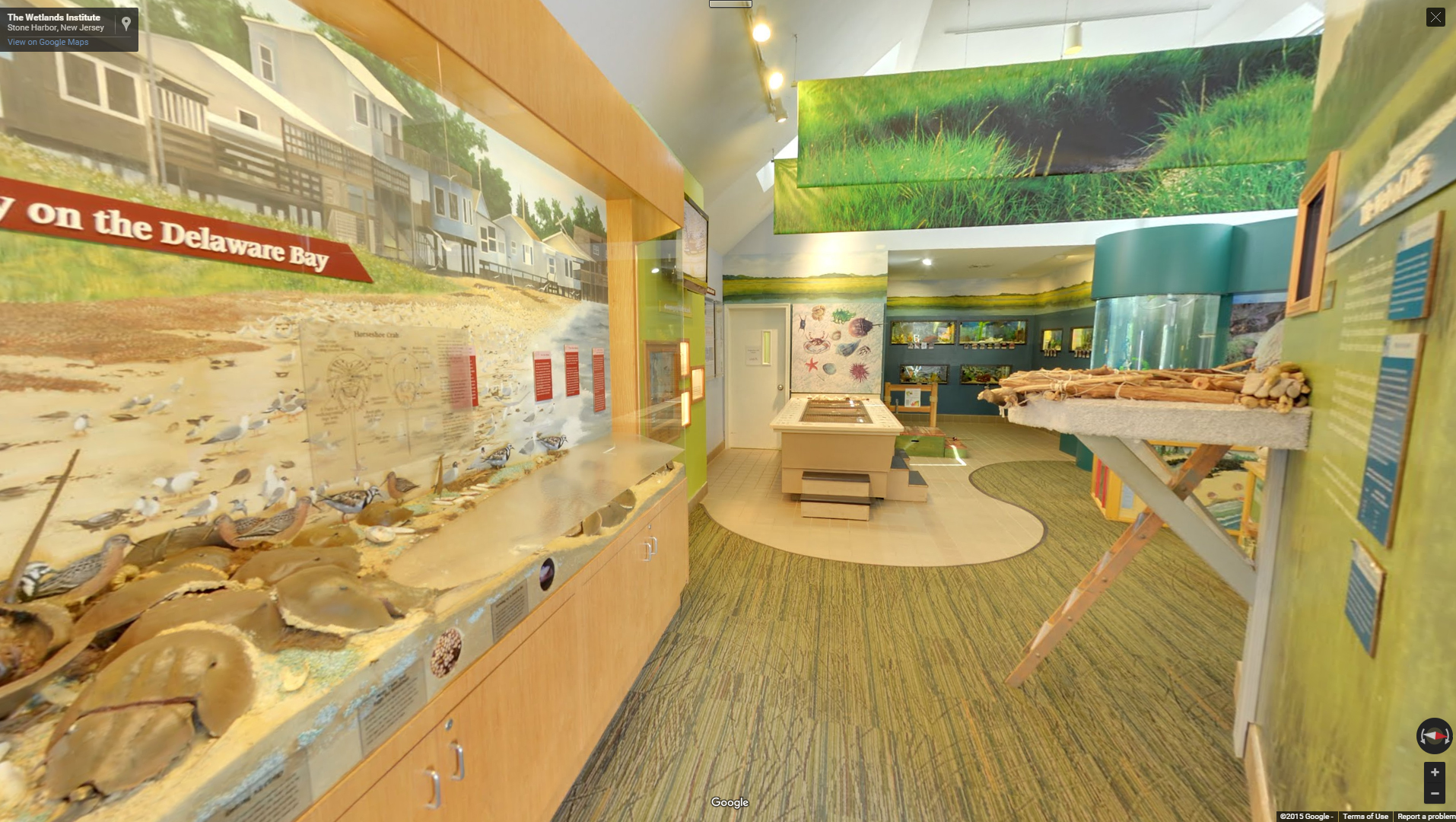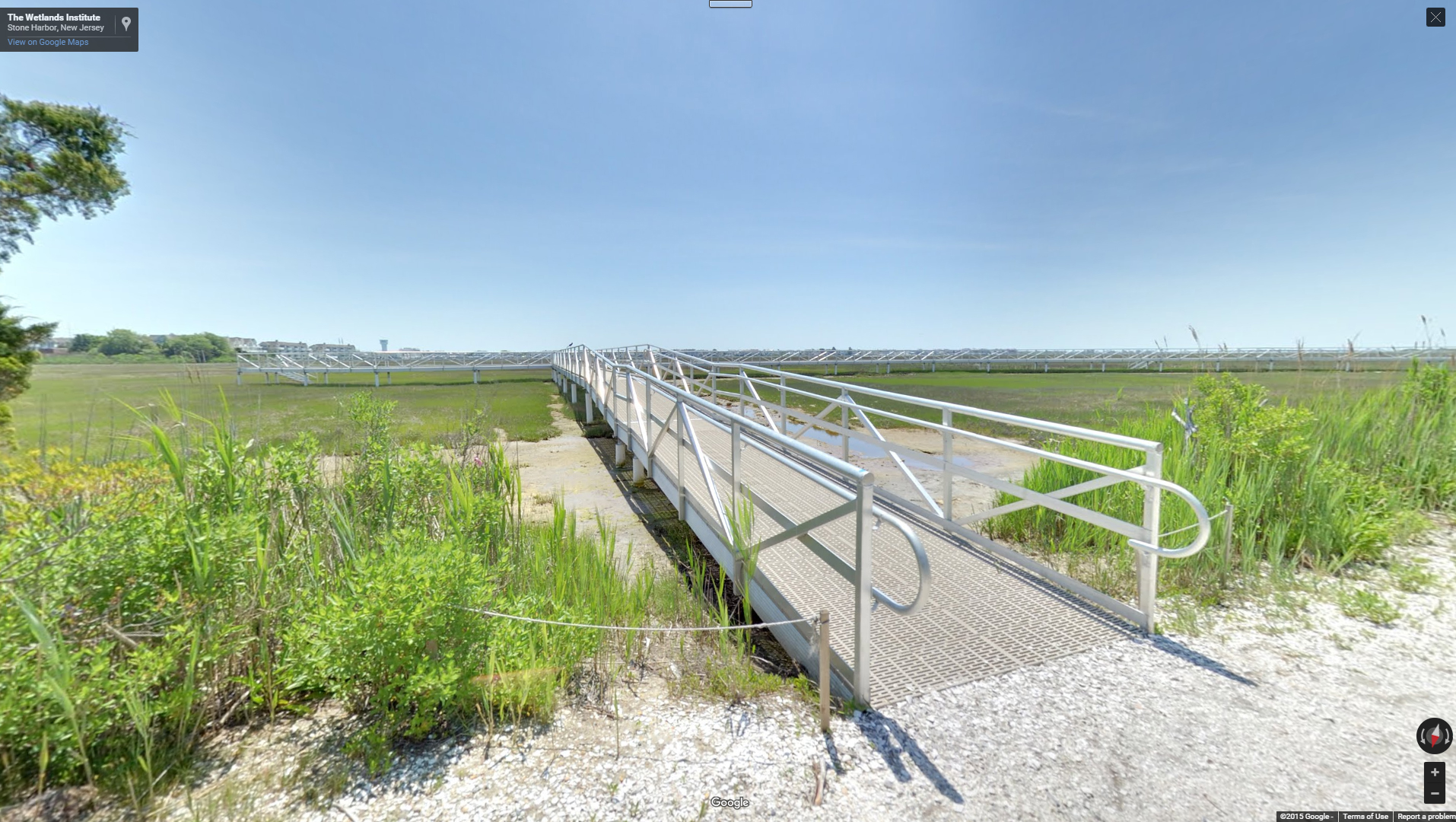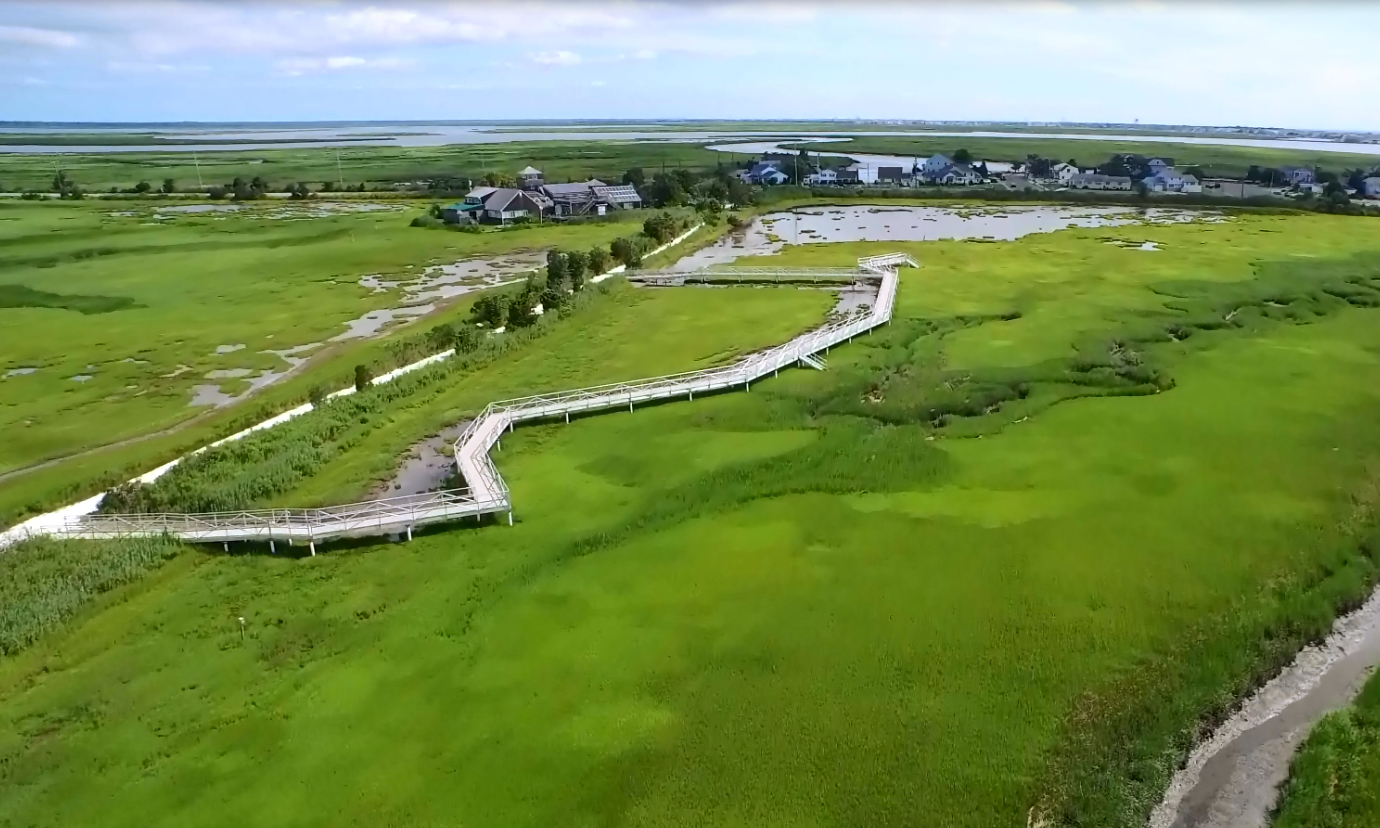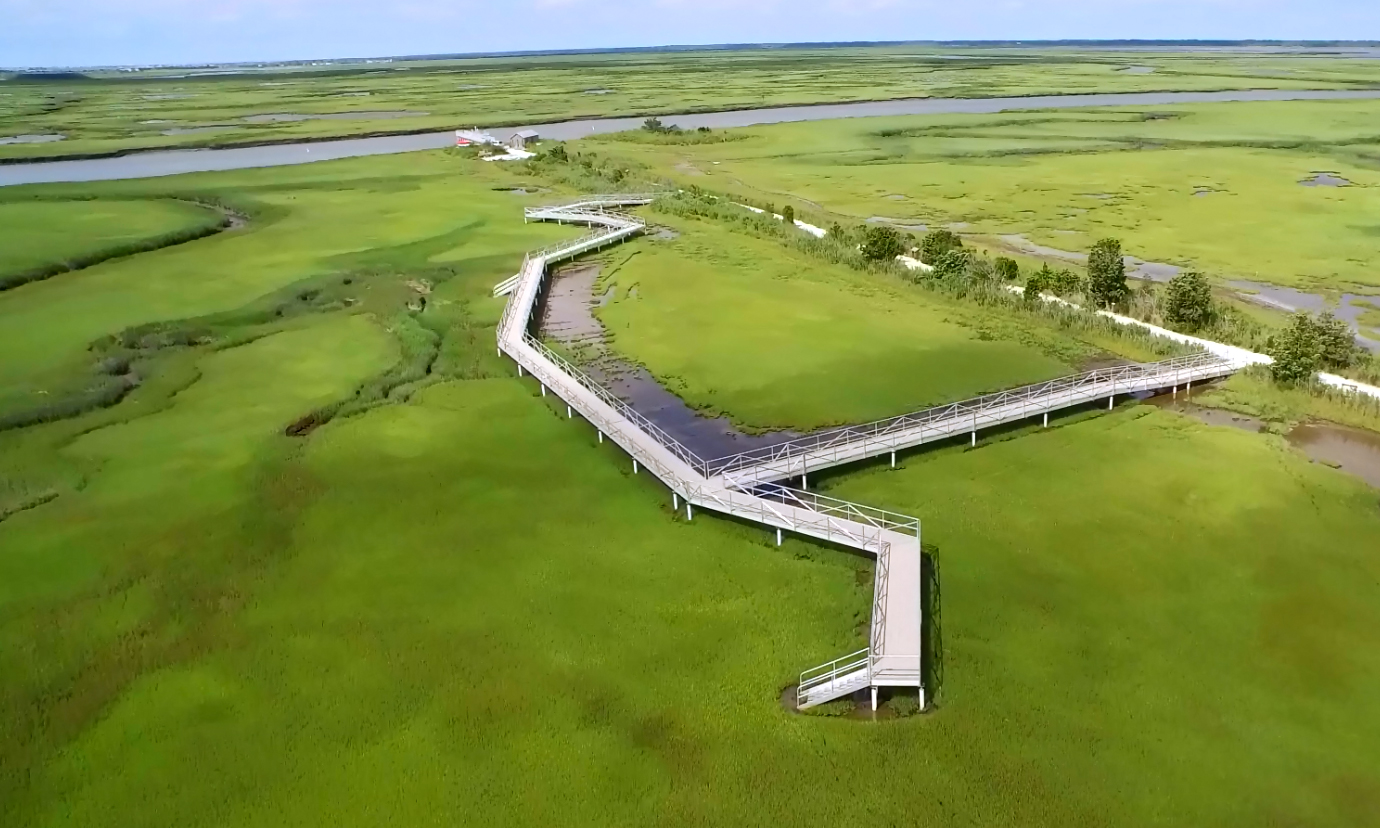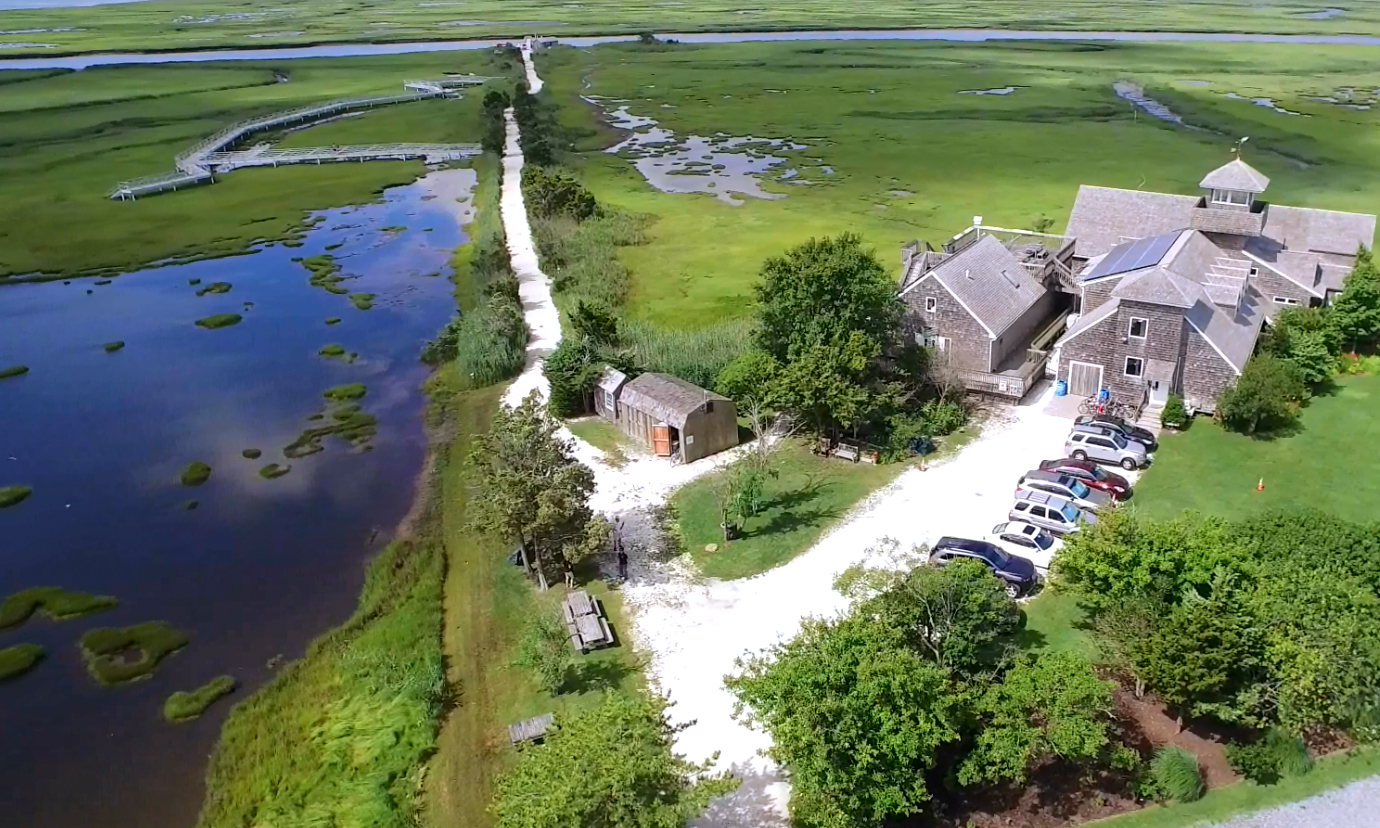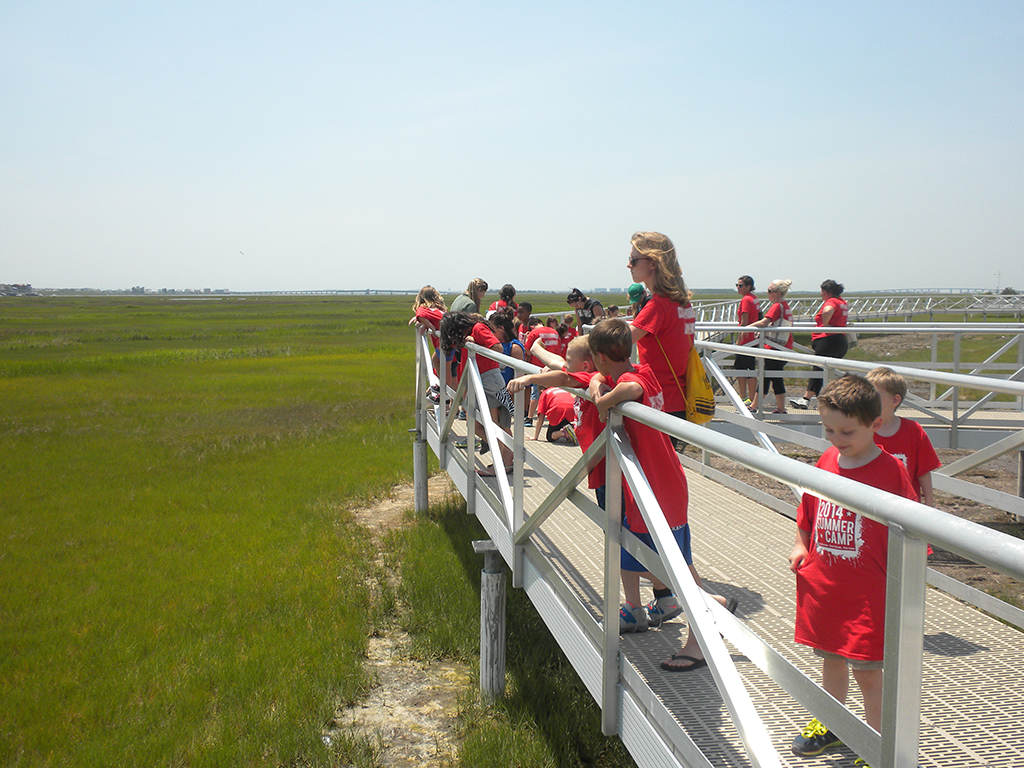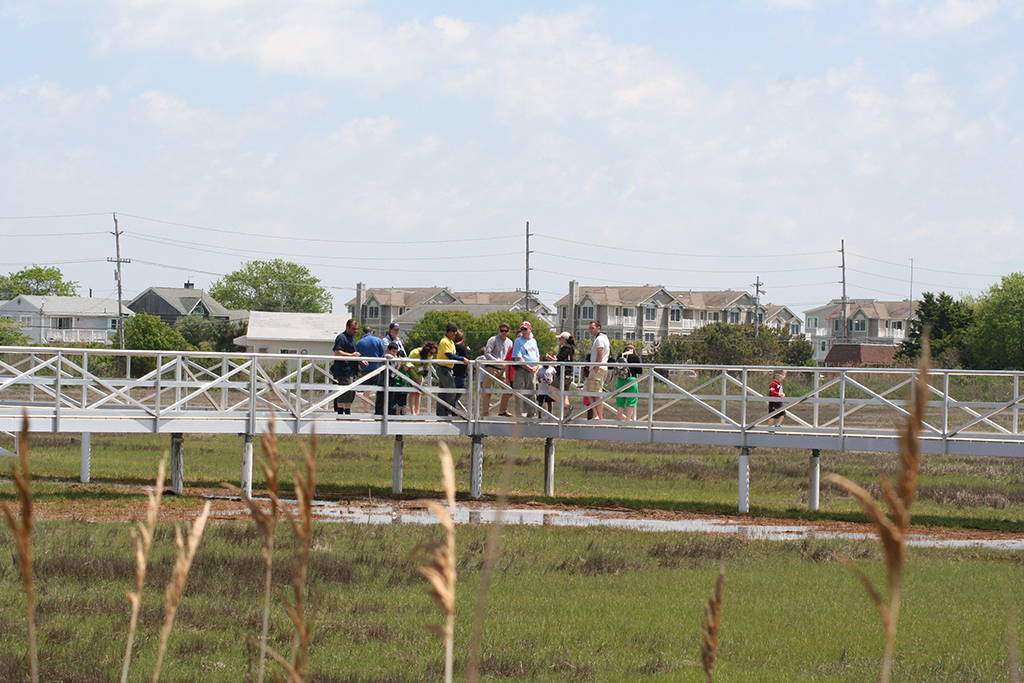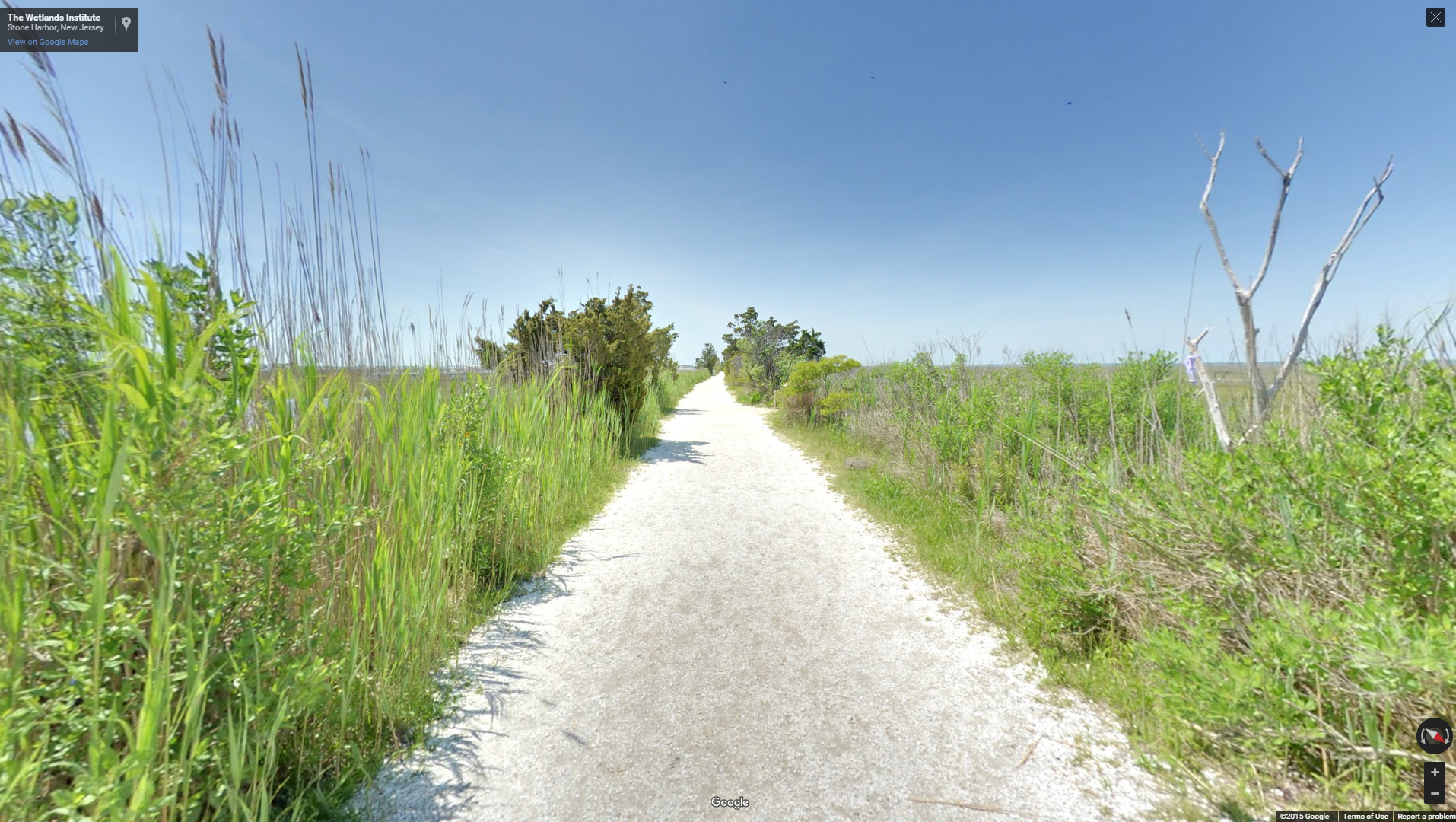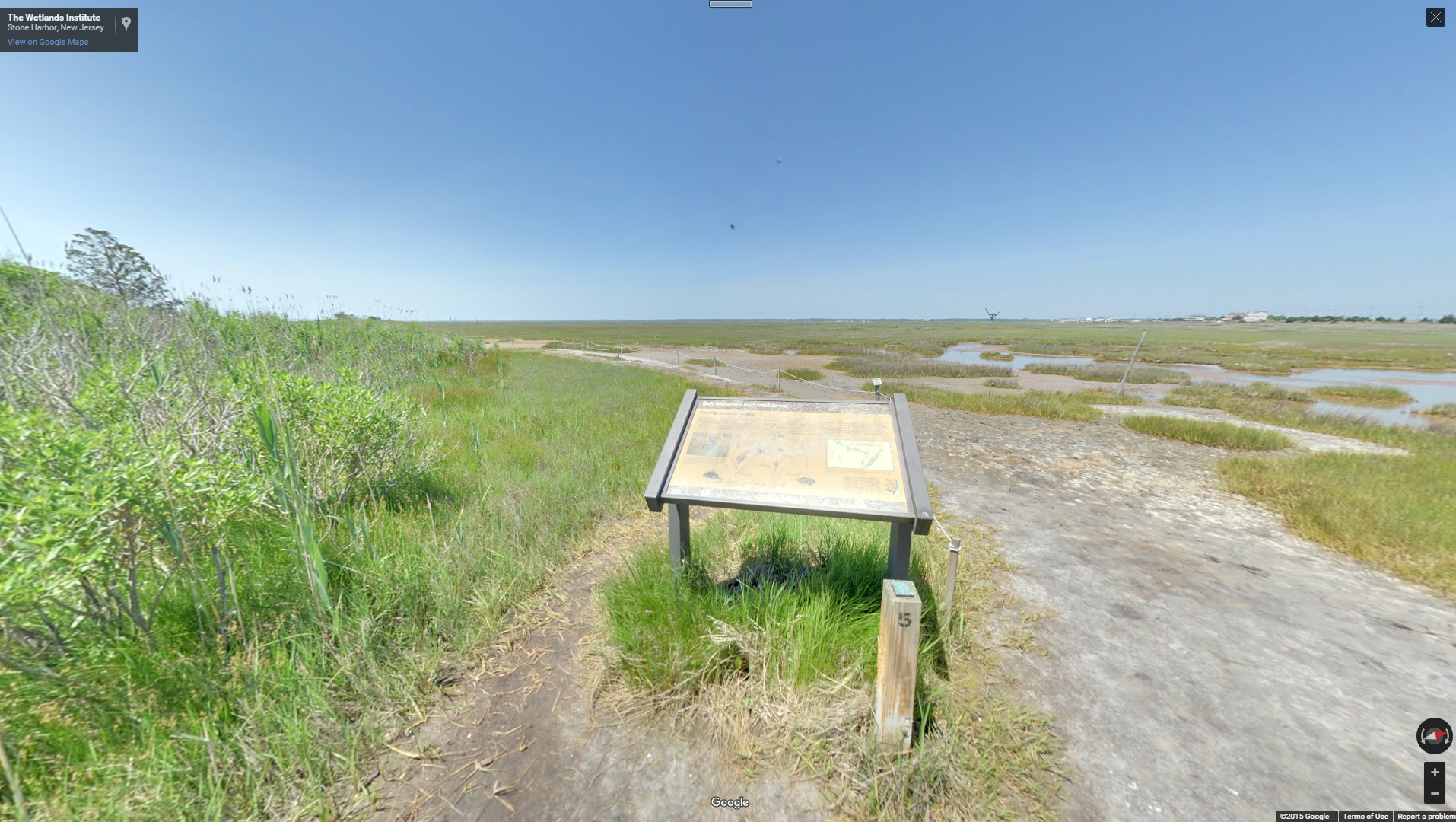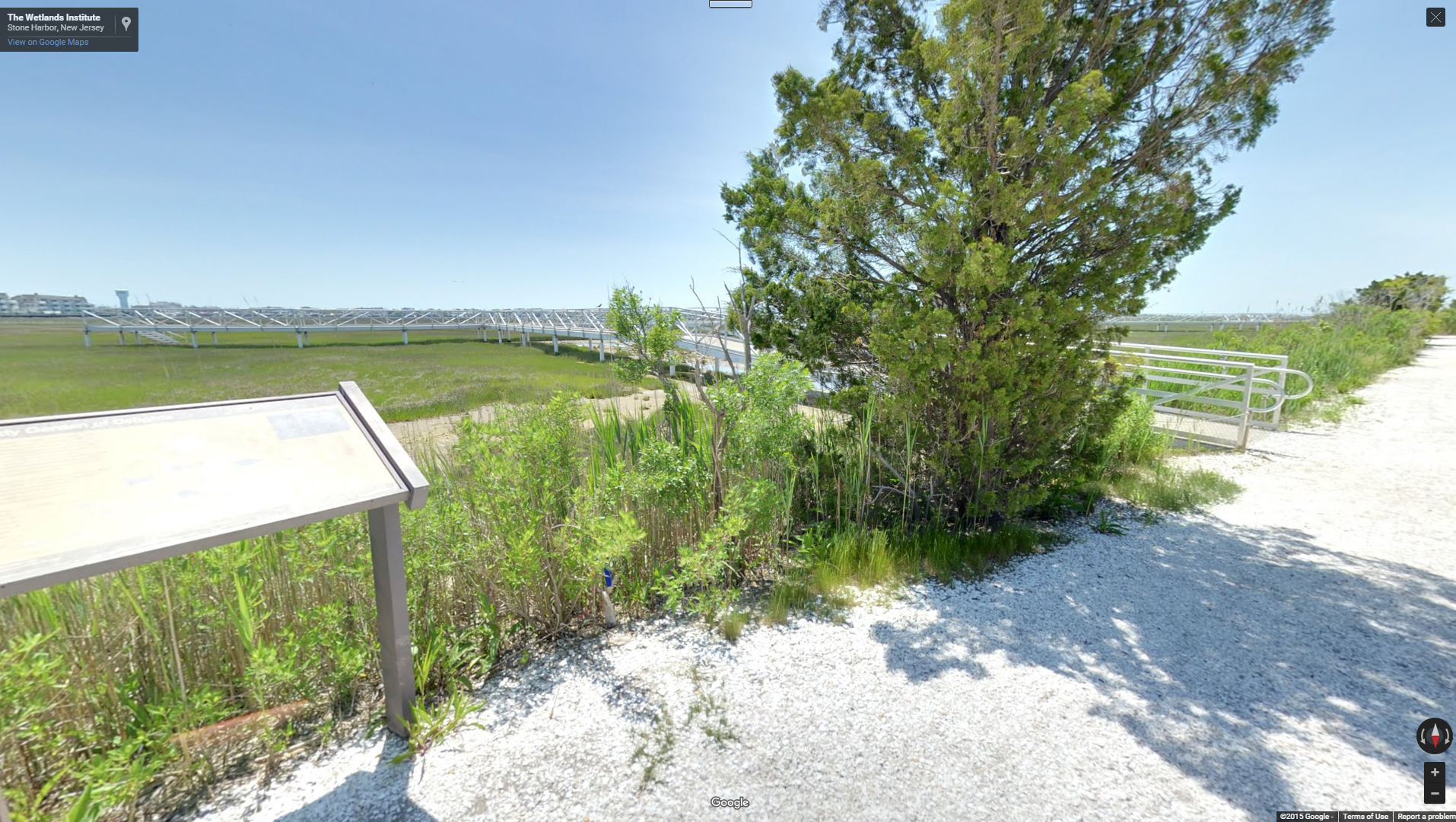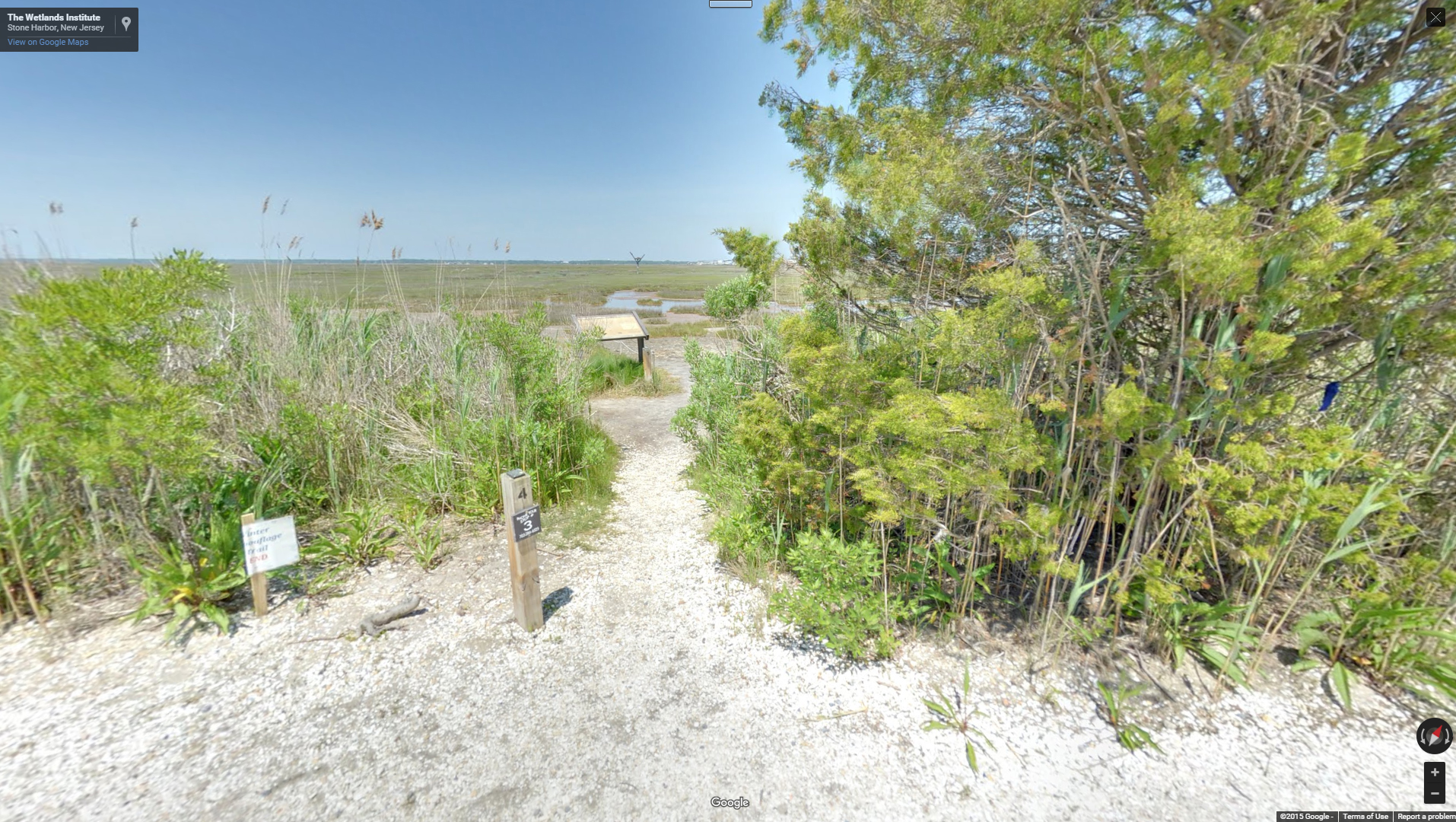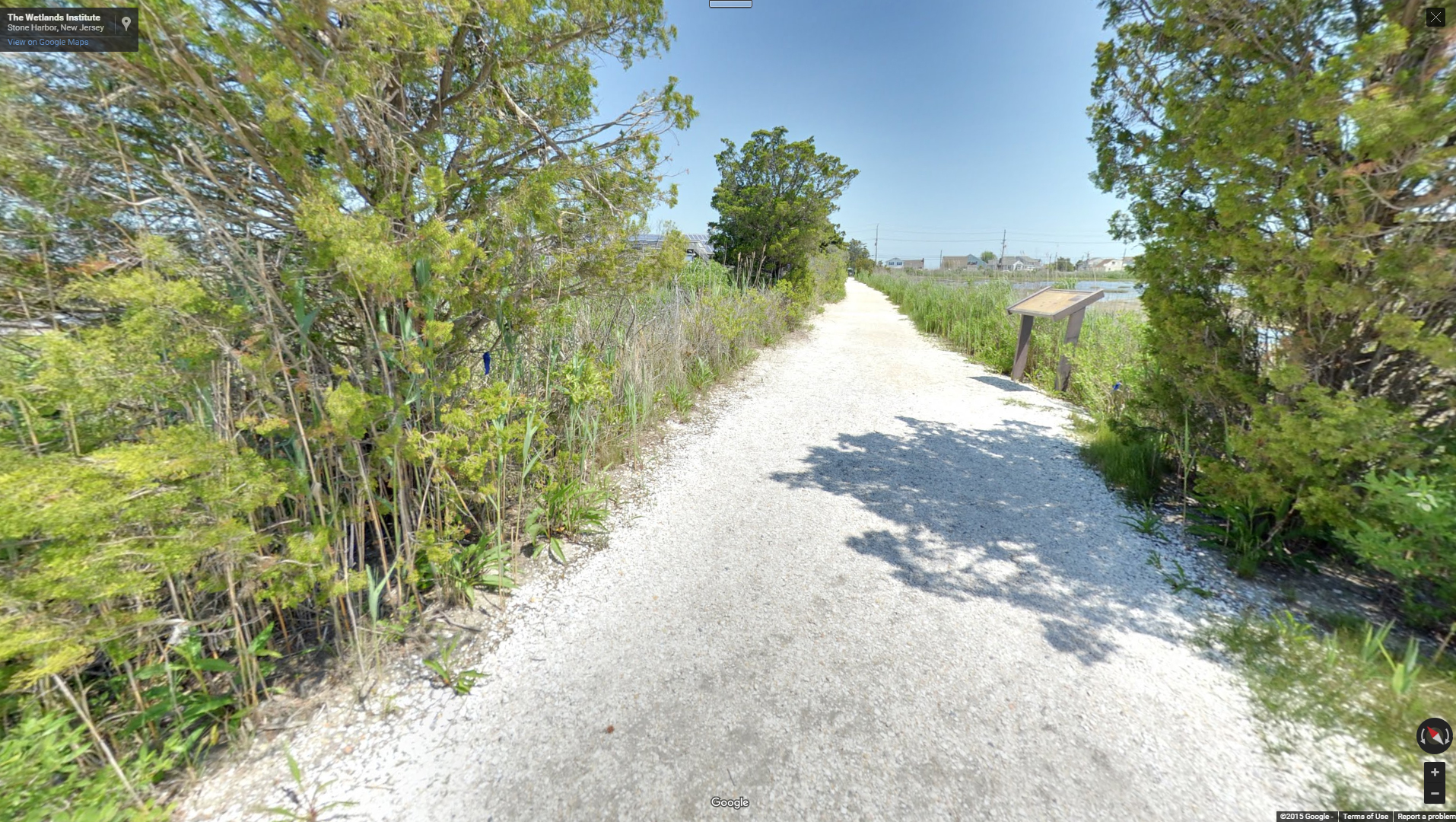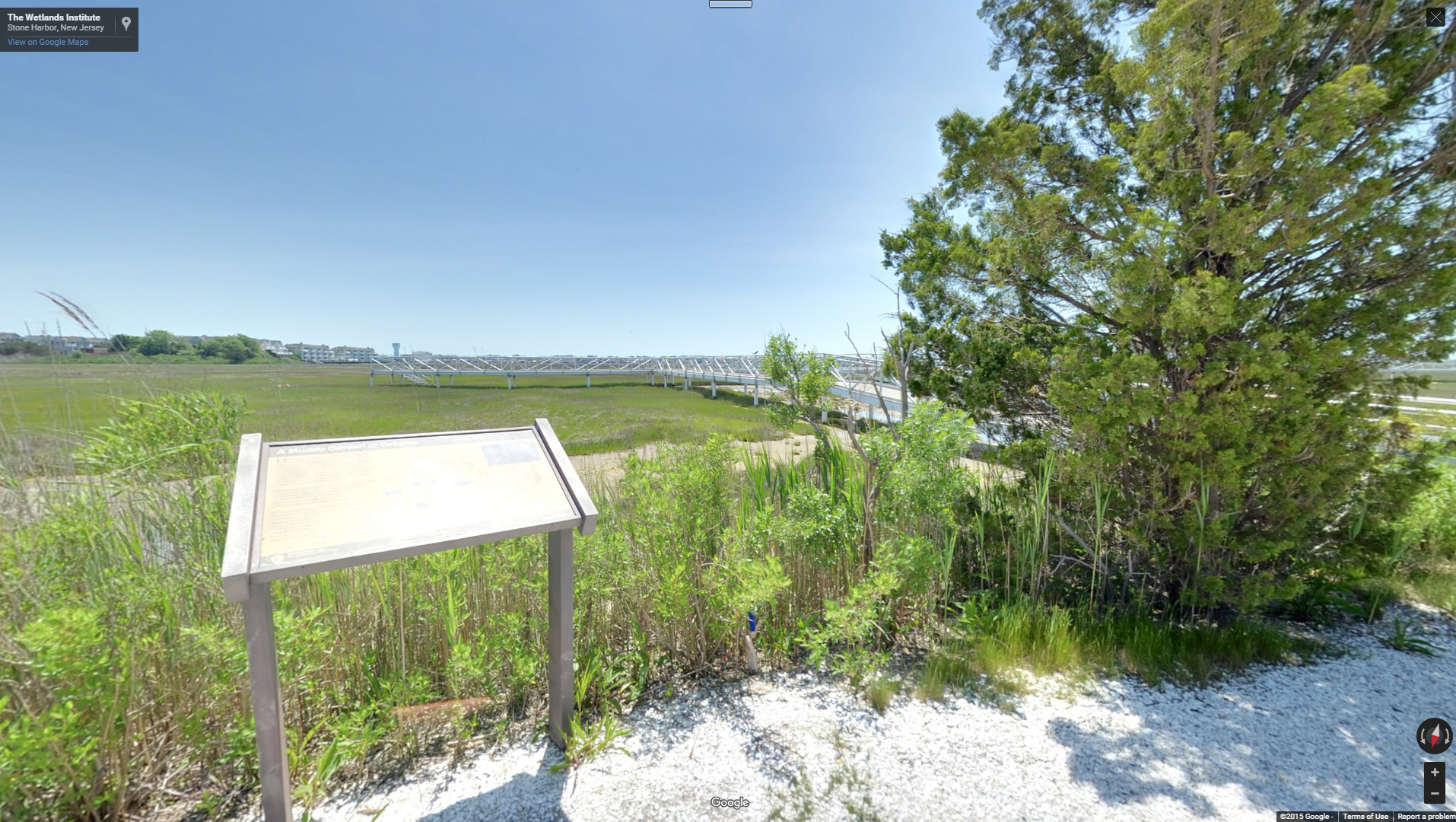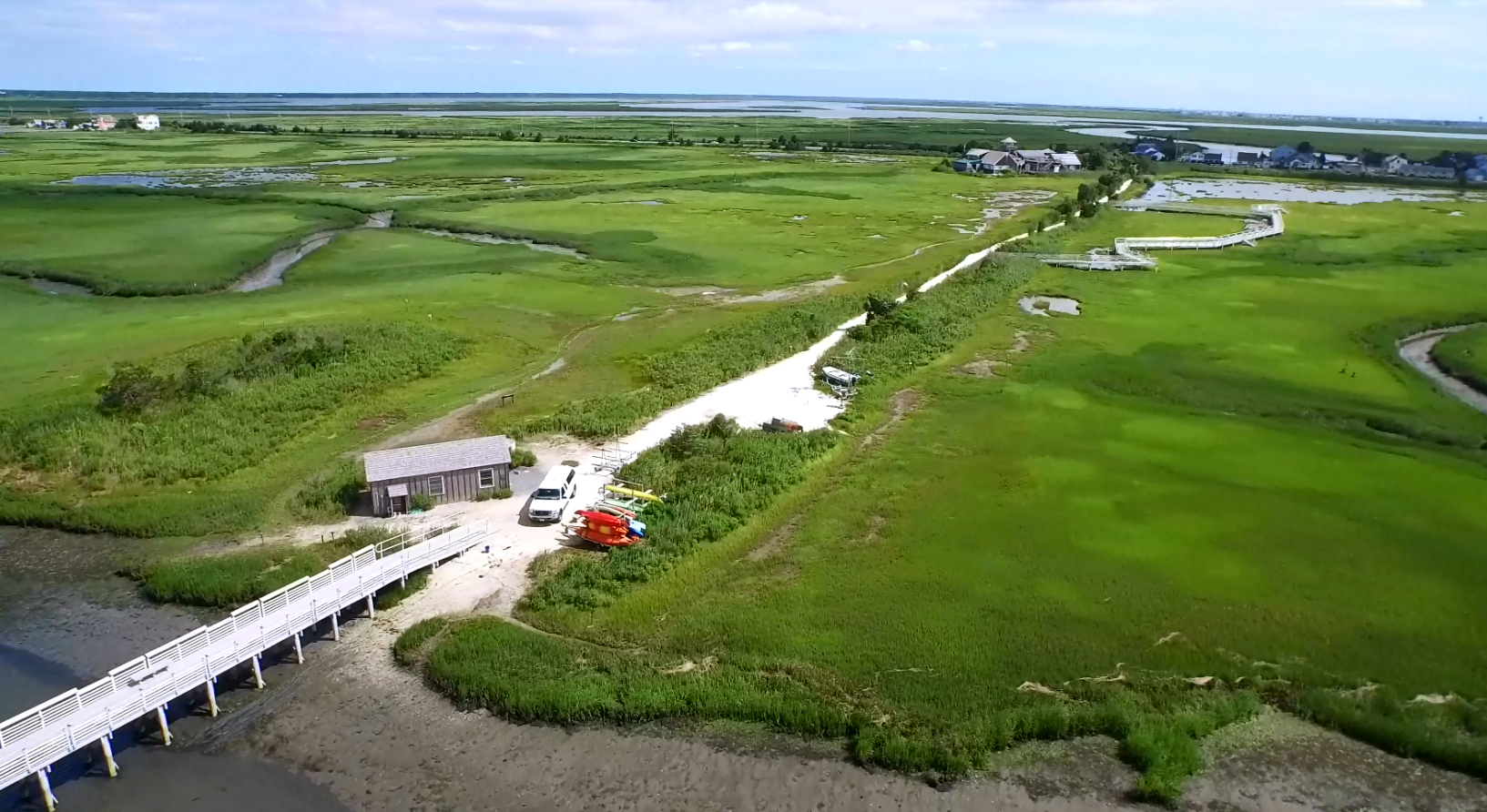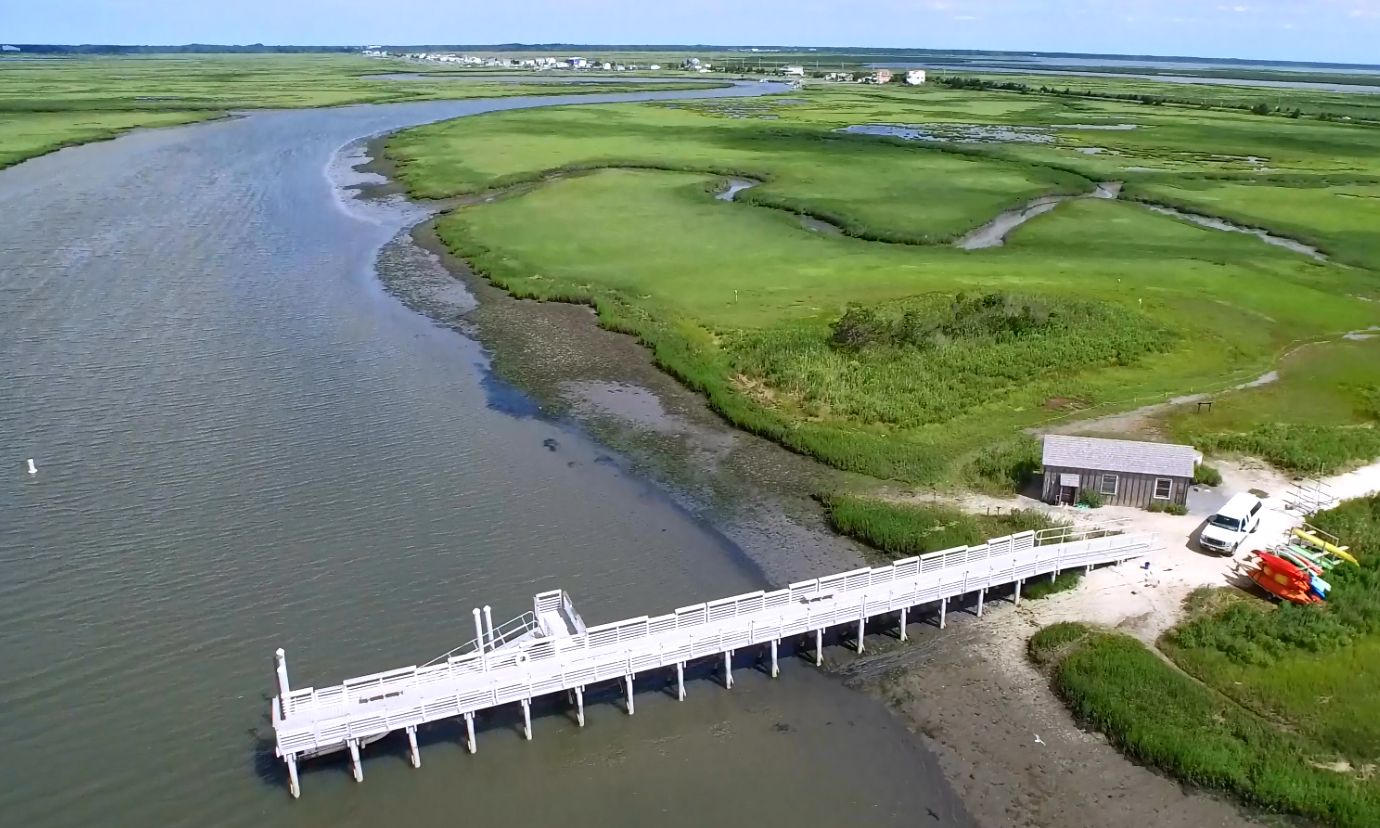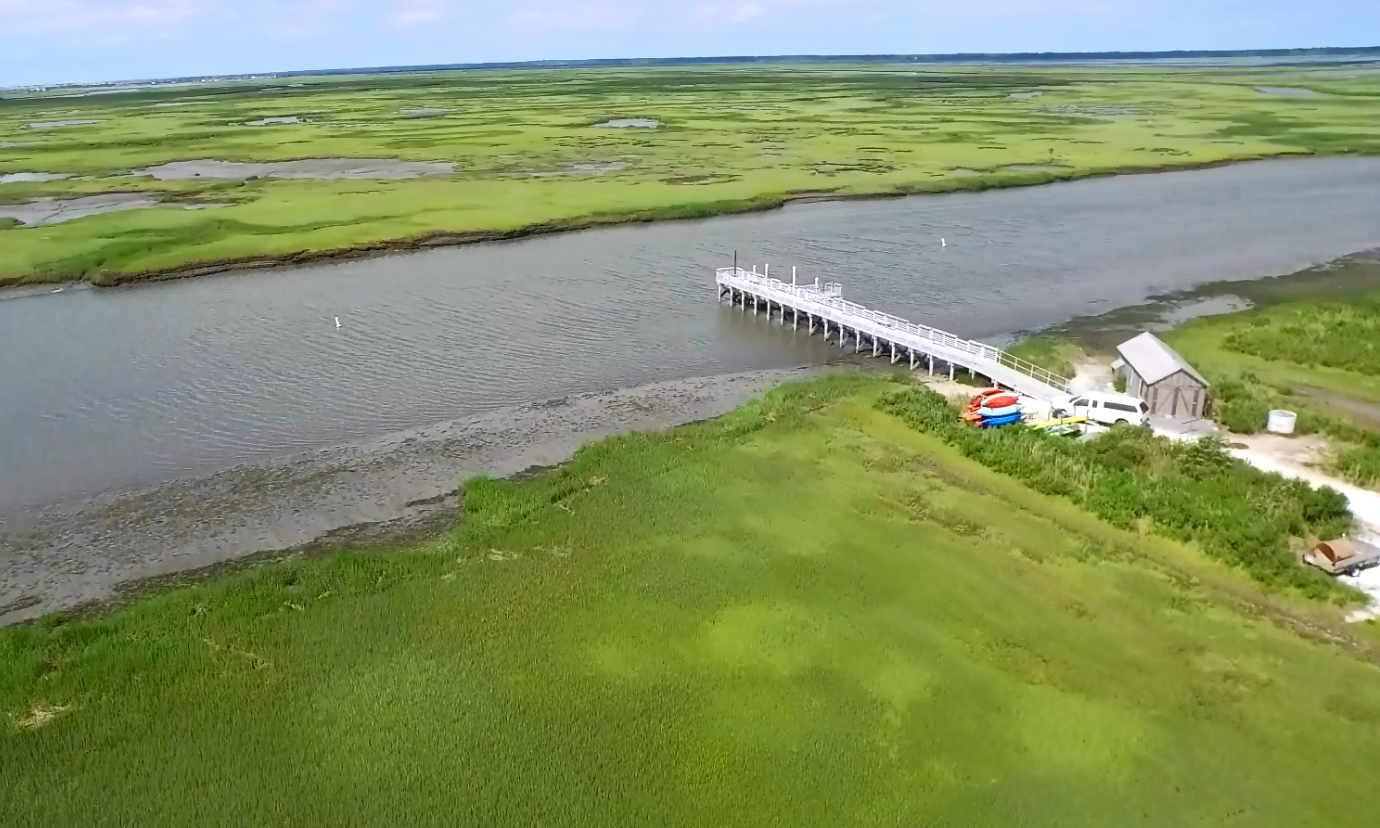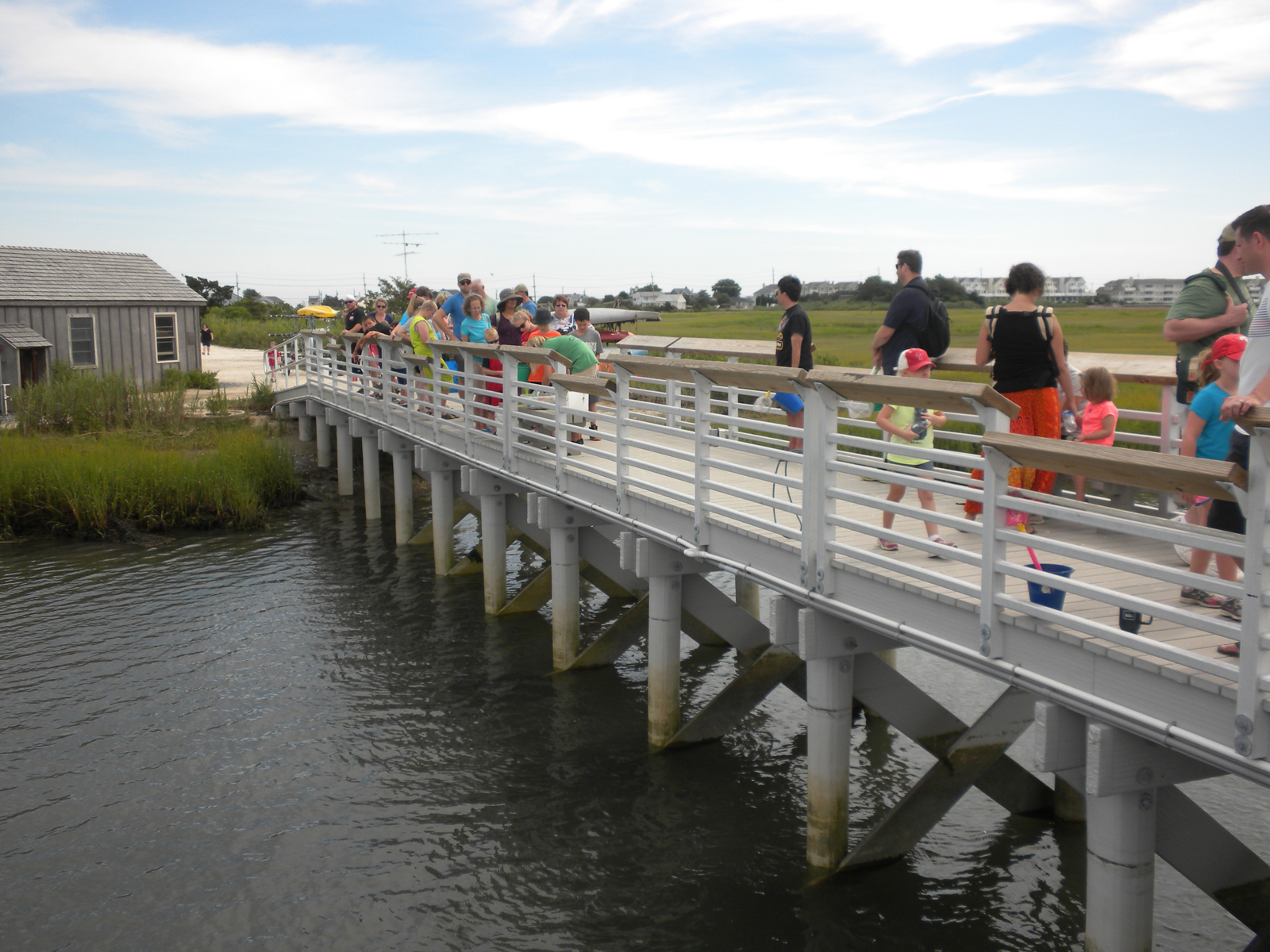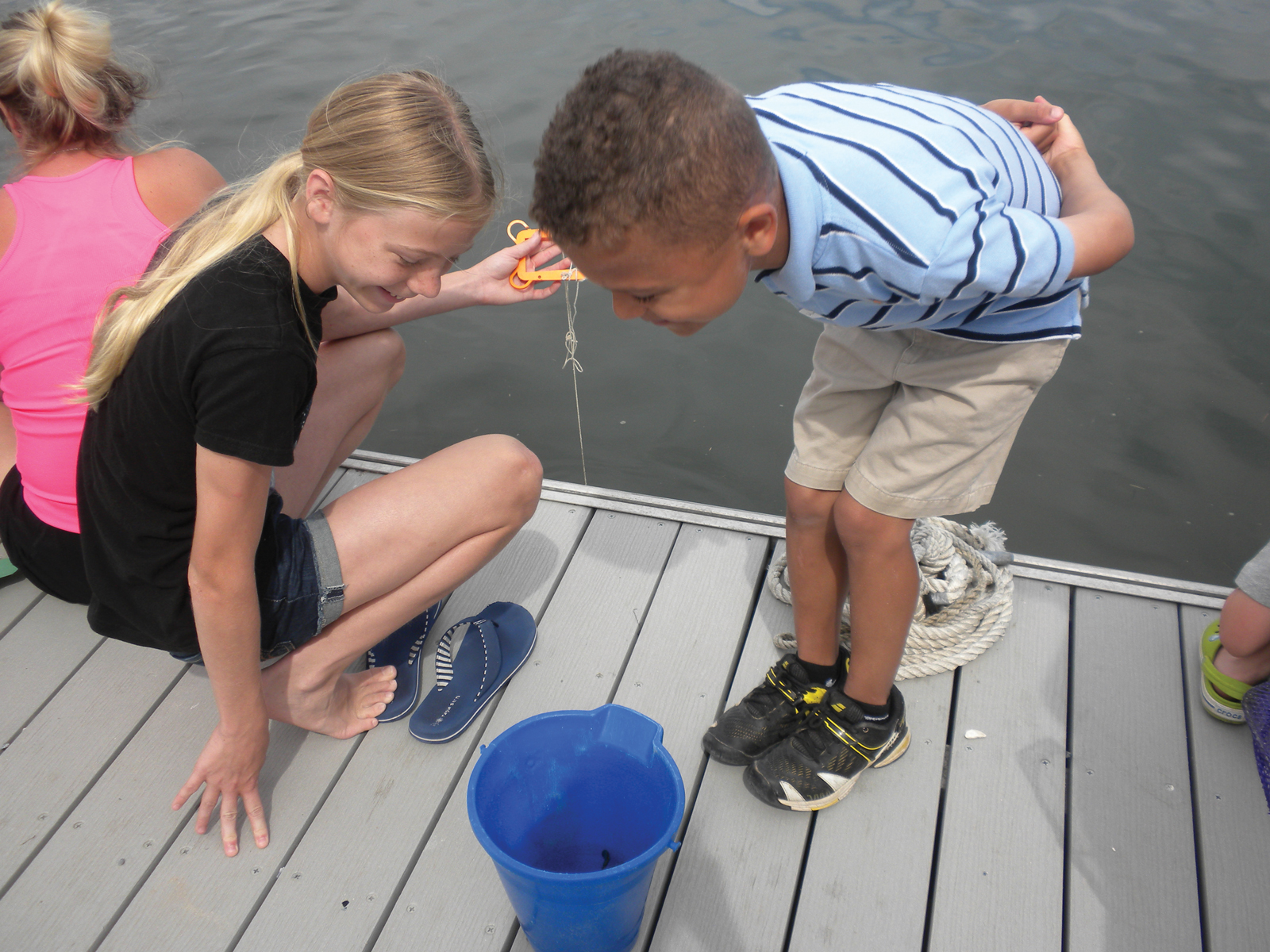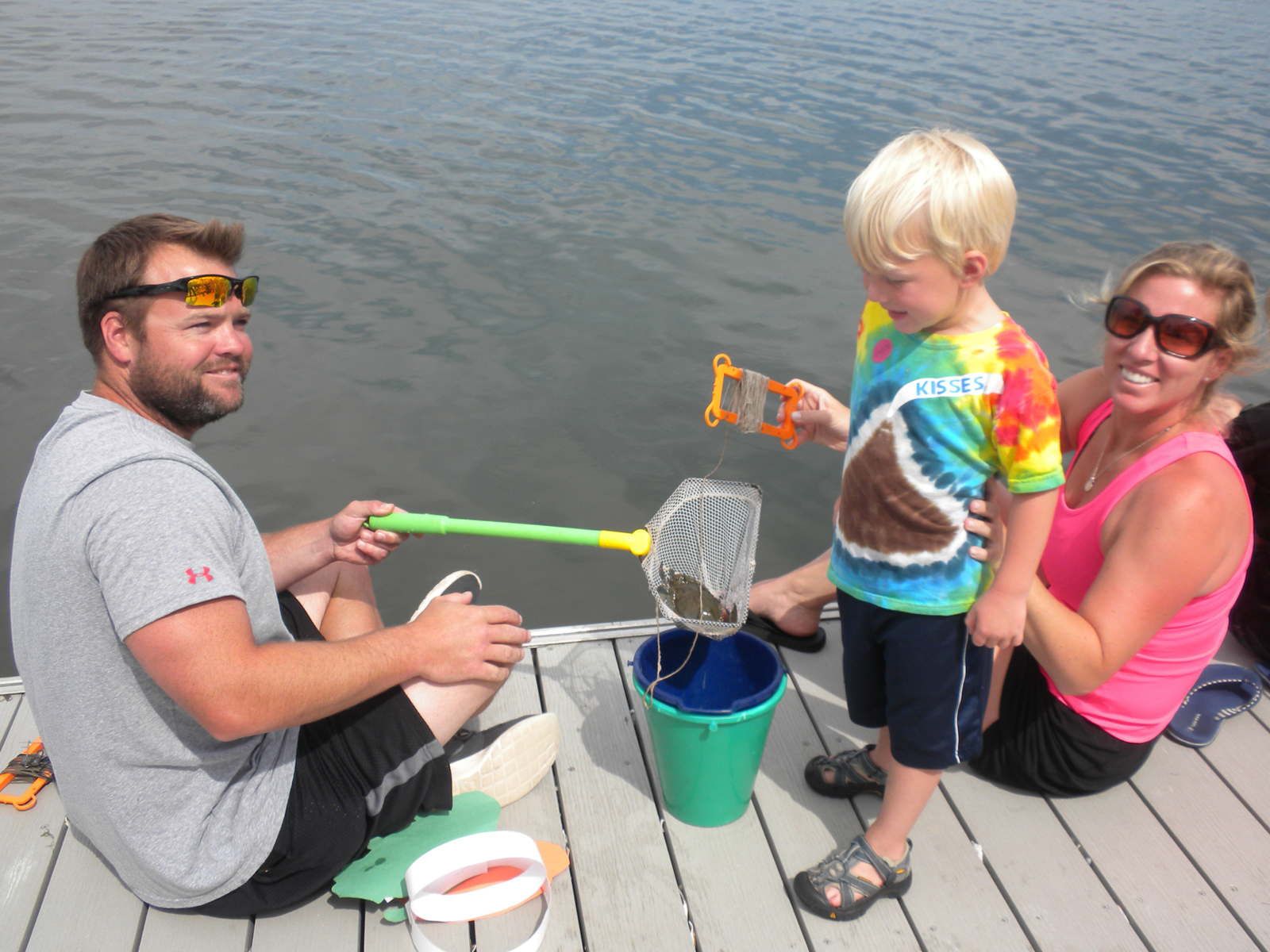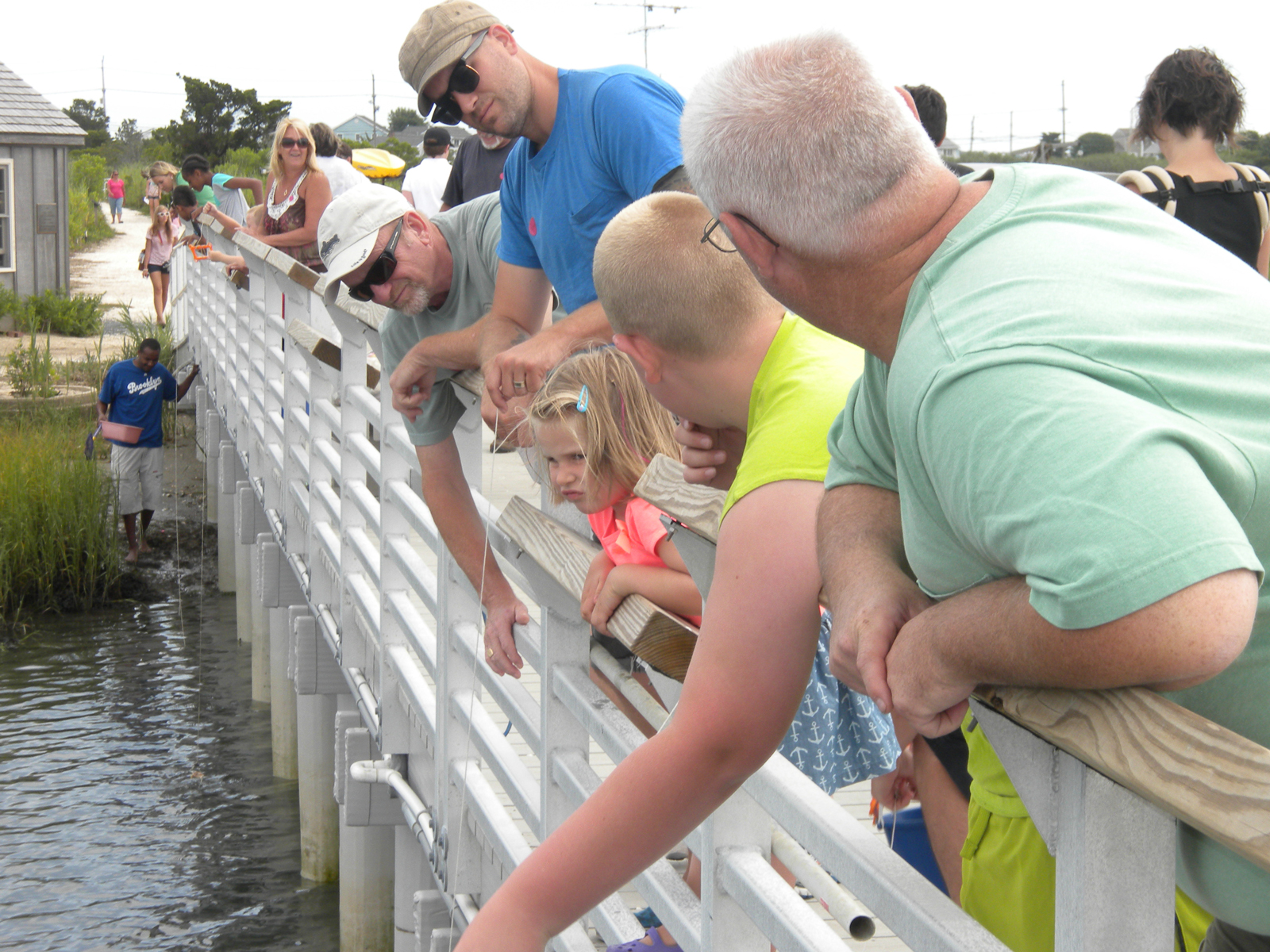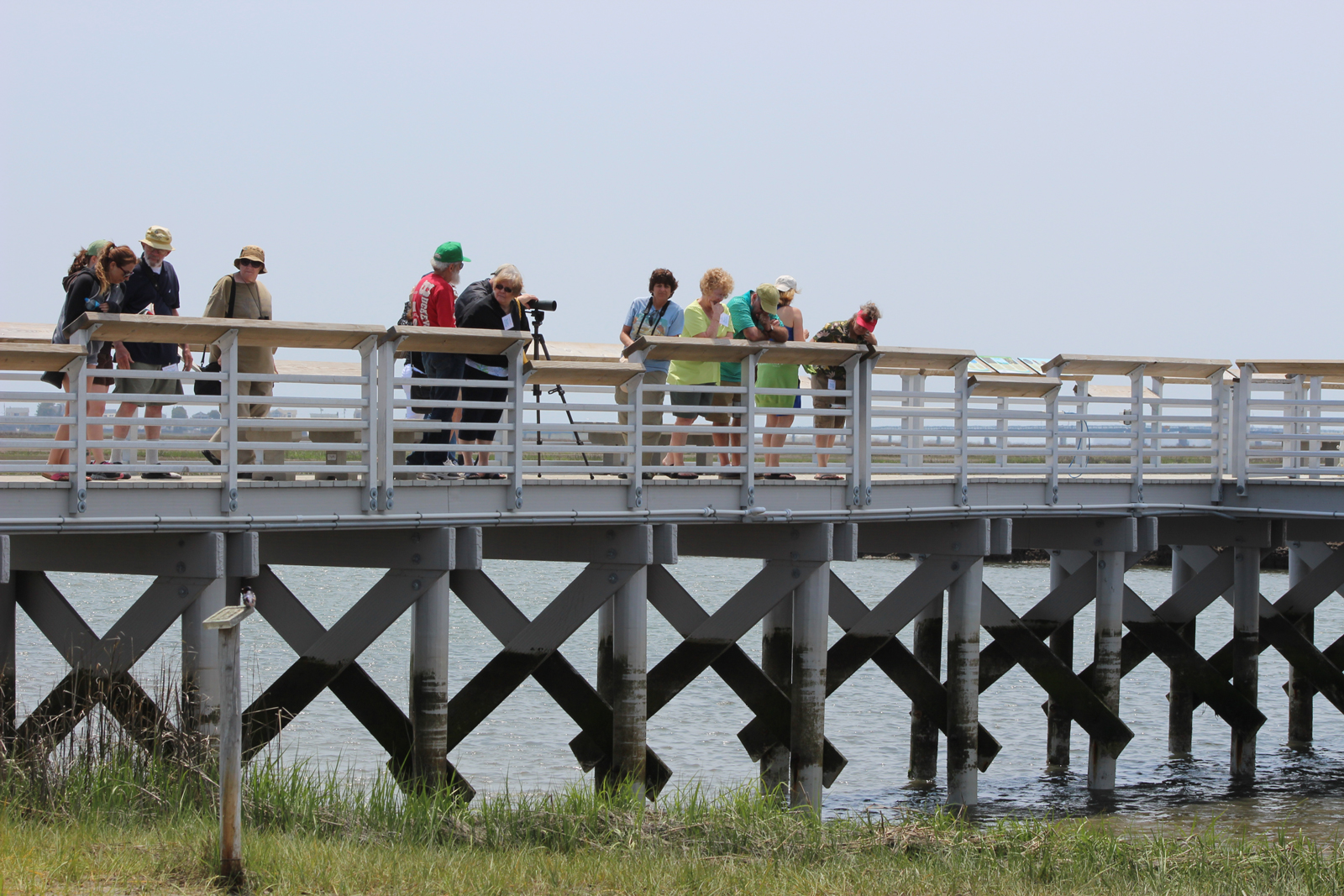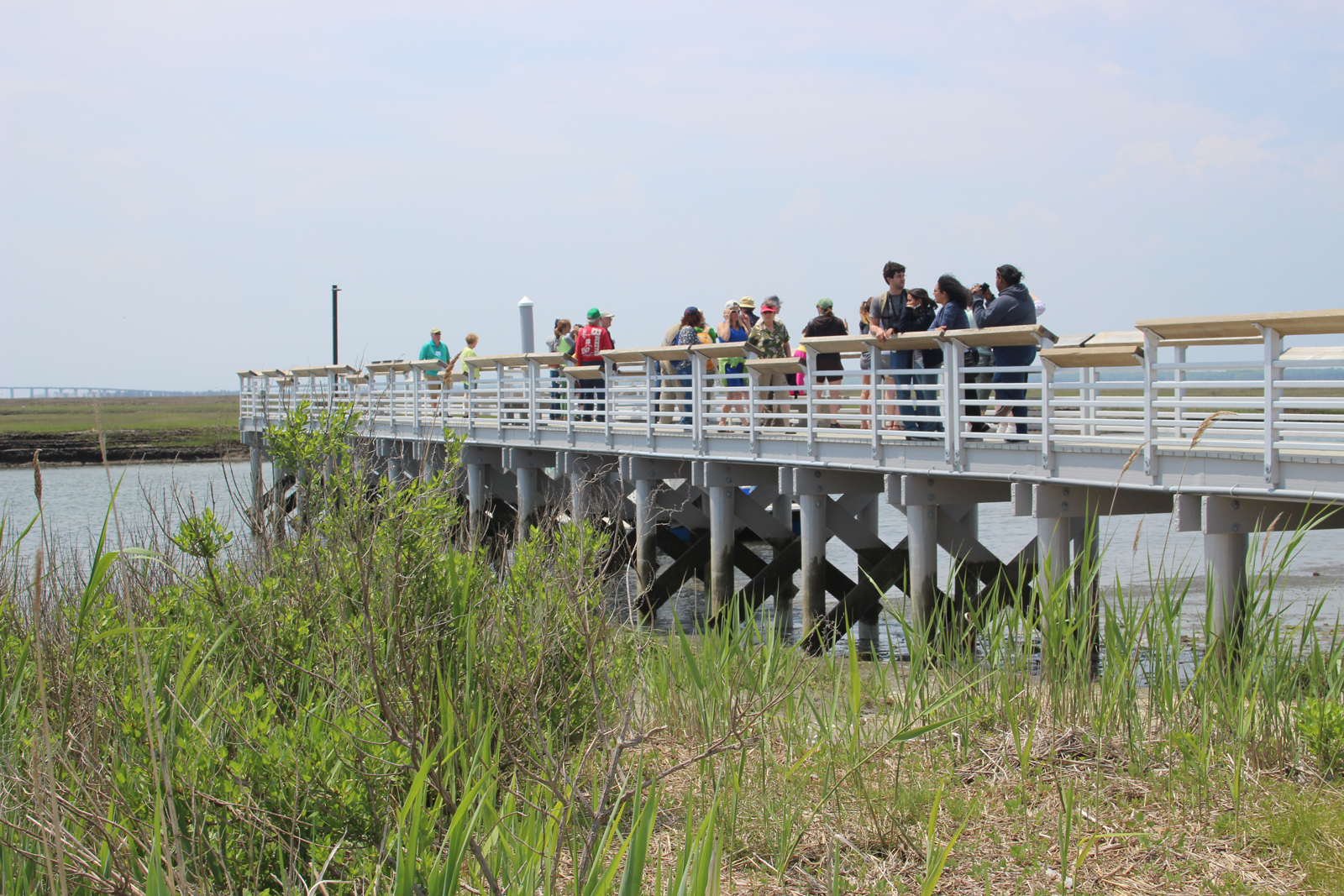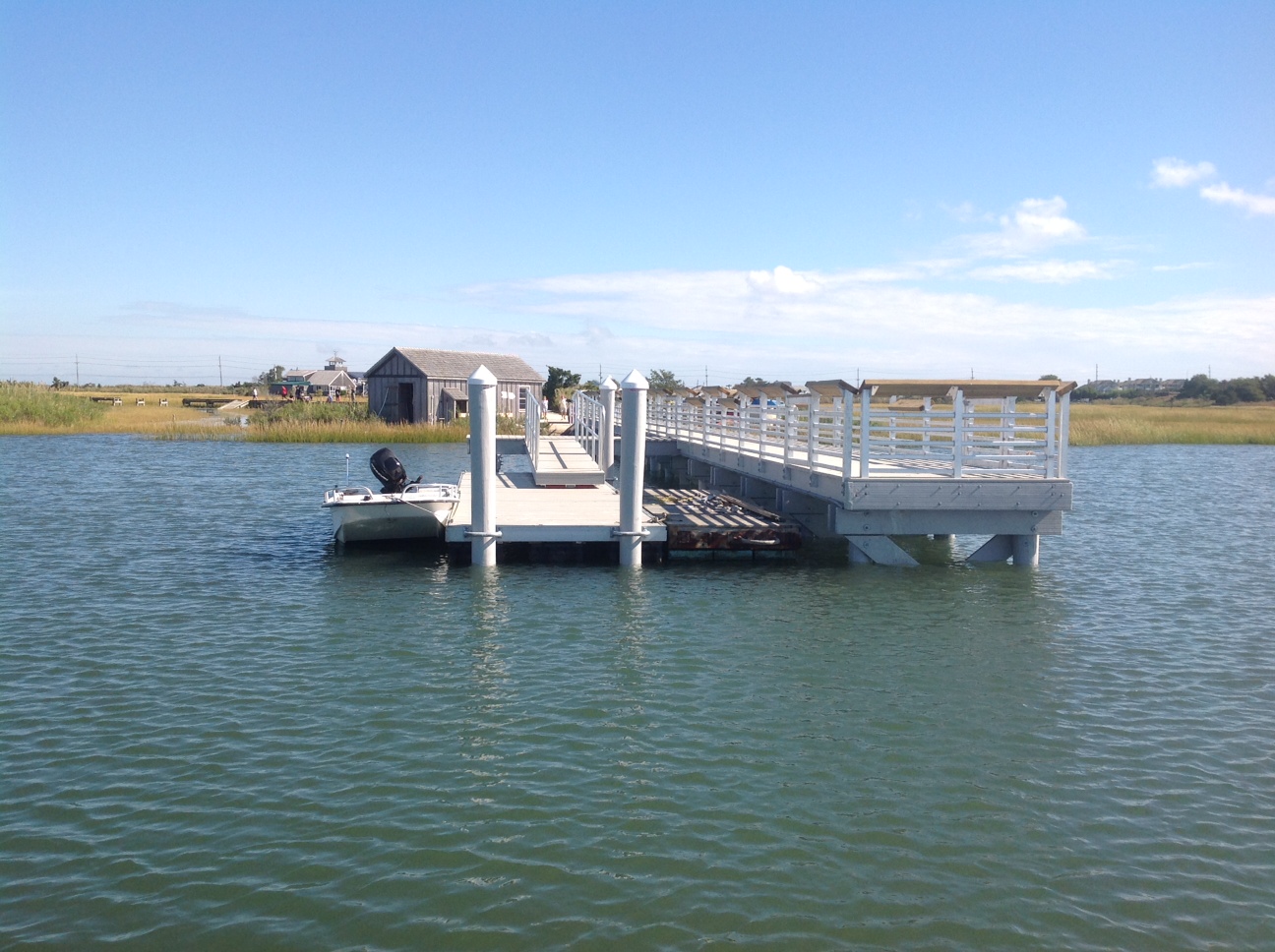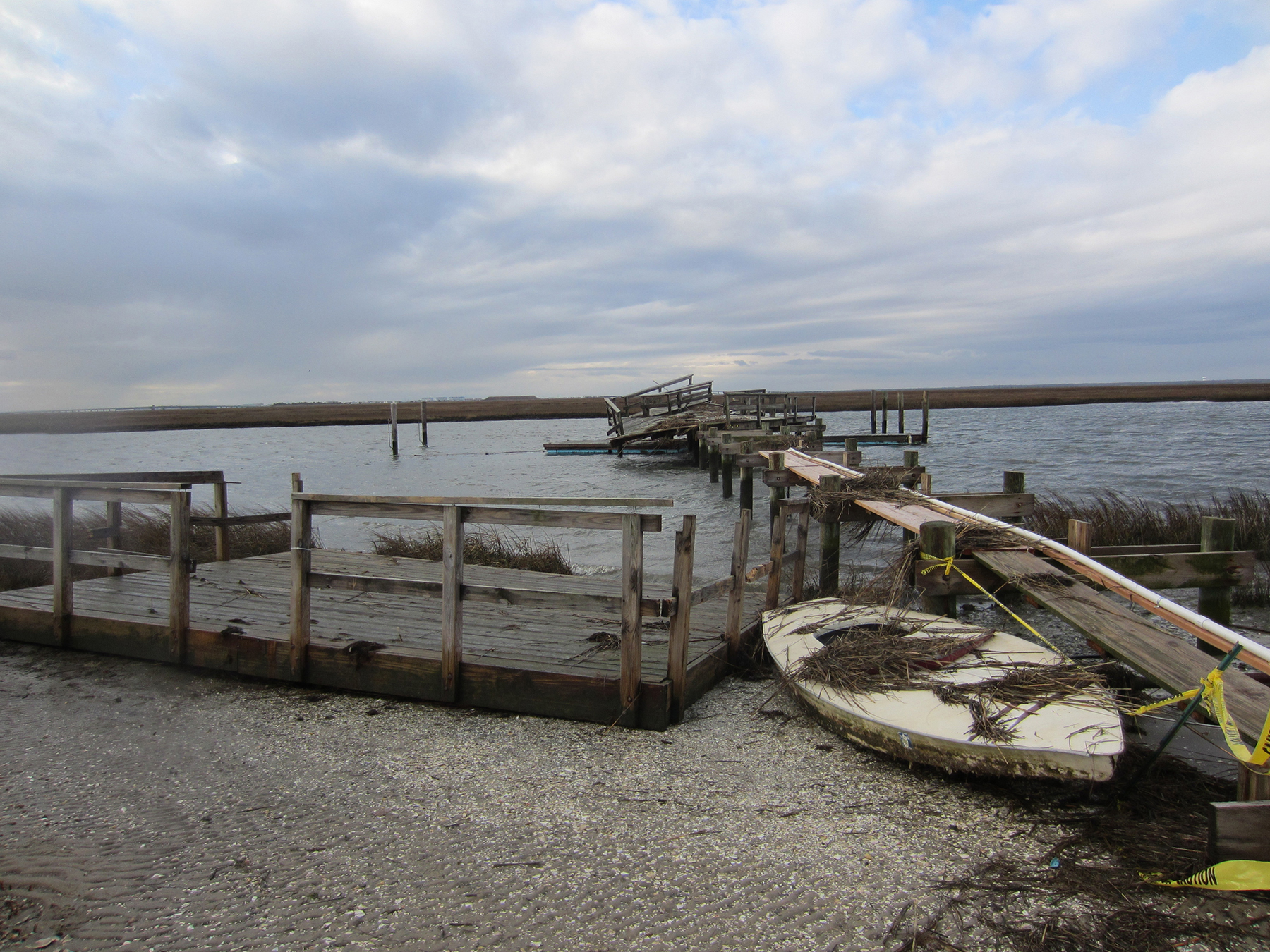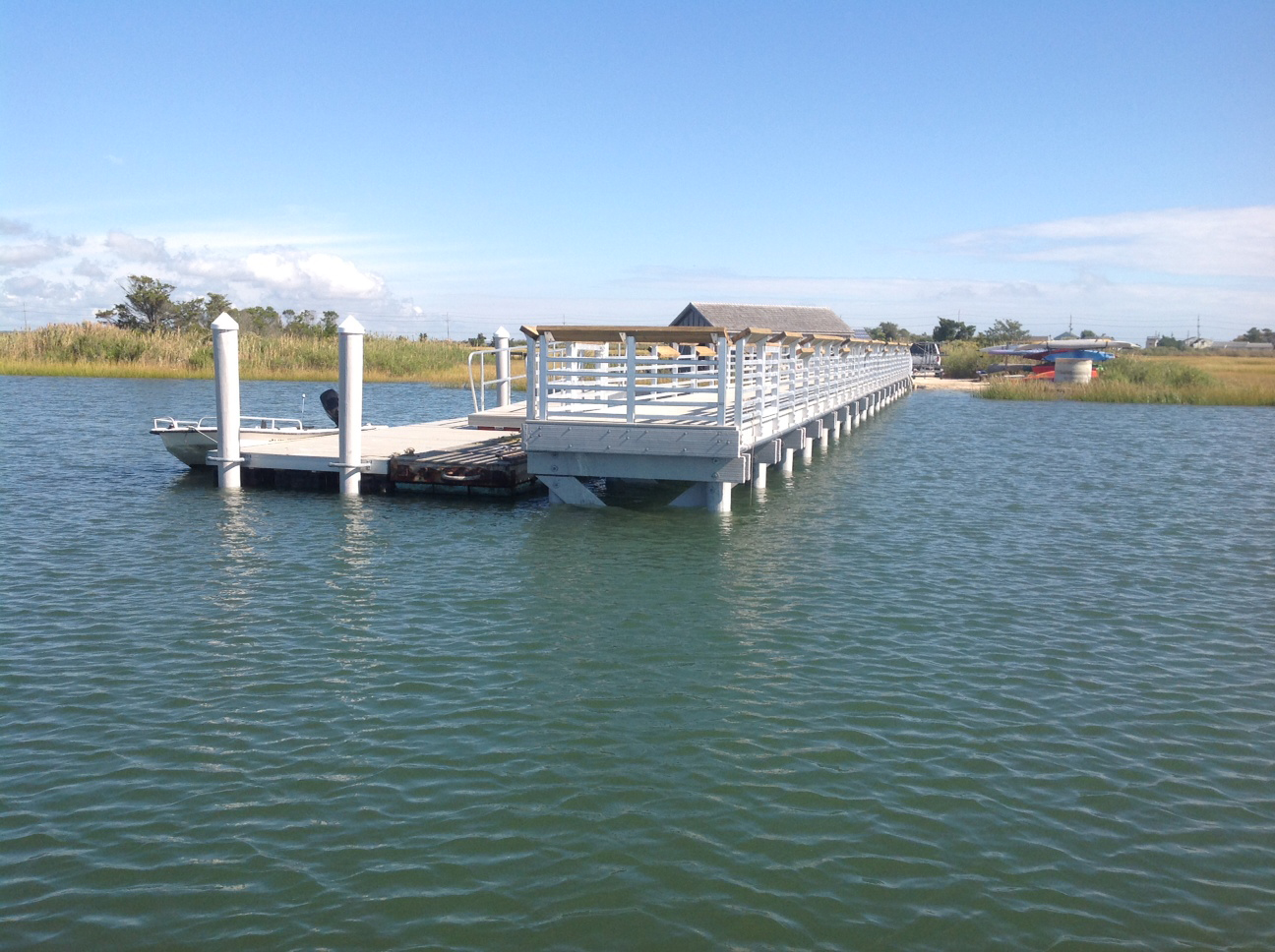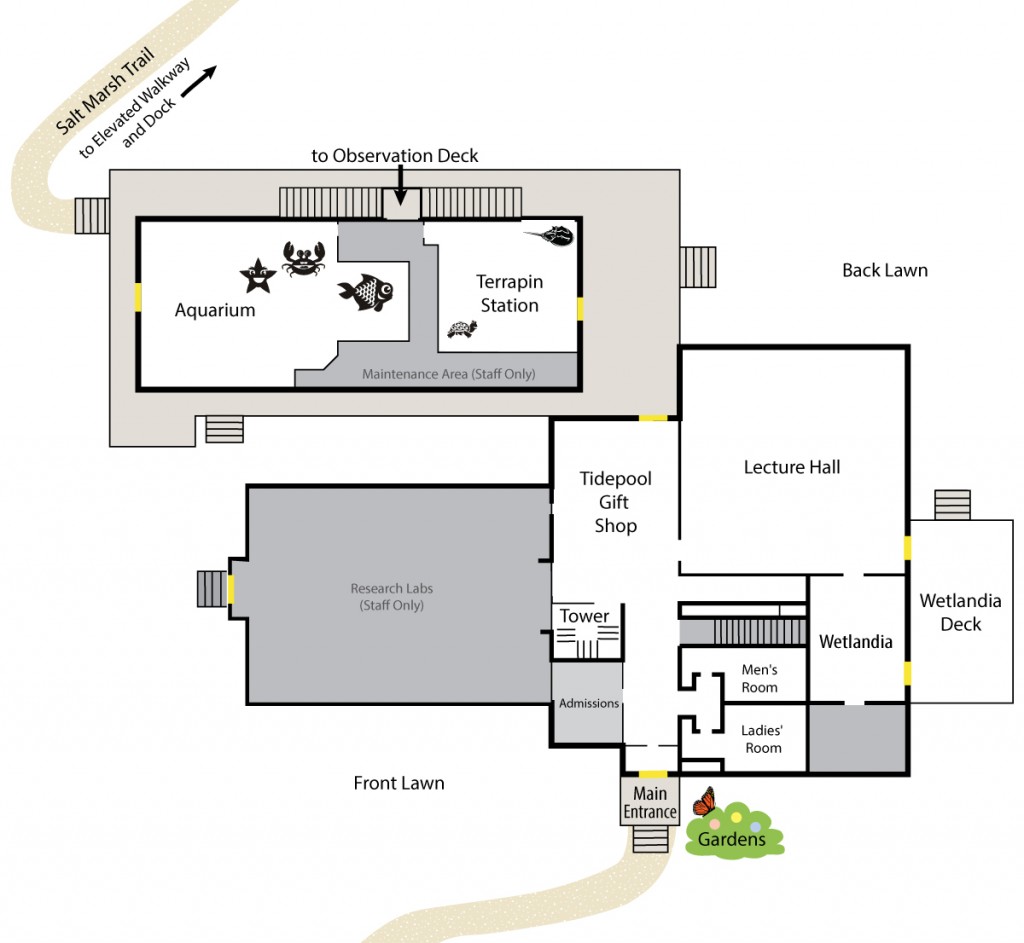Special COVID-19 Considerations: As you prepare for your visit, please know that masking is optional at The Wetlands Institute and we respect individual choice related to mask wearing. For the safety of others, please do not visit The Wetlands Institute if you are feeling ill.
Note: The Wetlands Institute is a natural conservation area where outside animals would be a disturbance to local wildlife that inhabits this area. Because of this, pets are not allowed inside Institute buildings or outside on Institute property, including the Salt Marsh Trail, elevated walkway, and dock. Service dogs are welcome as they have been trained to not react to other animals.
We look forward to seeing you soon for a safe, family friendly visit to The Wetlands Institute.
Click your way around the Institute:
Features:
- Tidepool Shop specializing in nature books, gifts and clothing.
- Elevated Marsh Walkway
- Dock
- Marshview Hall
- Diller Coastal Exhibit Building
- Salt Marsh Trail (take an interactive tour!)
- Observation Tower
Bike racks, picnic and rest areas. Free parking Public Building Handicap Accessible.
Directions:
From Philadelphia: Atlantic City Expressway to Exit 7 South (Garden State Parkway). Parkway South to Exit #10 for Stone Harbor. Turn left on Stone Harbor Blvd. The Institute is 2.5 miles on right.
From North Jersey: Garden State Parkway south to Exit #10 for Stone Harbor. Turn left on Stone Harbor Blvd. The Institute is 2.5 miles on right.
From Wilmington: Delaware Memorial Bridge to Rt. 40, to Rt. 55 south, to Rt. 47, to Rt. 657 east to Stone Harbor.
From Eastern Shore: Lewes, Delaware Ferry to Cape May, to Garden State Parkway north, to Exit #10 for Stone Harbor. Turn right on Stone Harbor Blvd. The Institute is 2.5 miles on right.
Autumn/Winter Hours
Open Saturdays and Sundays 9:30am to 4:30pm.
Special Hours Notice:
It is sometimes necessary to close a building or facility to the public for part or all of a day due to maintenance repairs or special events. Please call ahead to verify hours.
The Wetlands Institute 1075 Stone Harbor Blvd. Stone Harbor, NJ 08247-1424.
Phone: 609.368.1211 Fax: 609.368.3871
Admission: $12.00 ages 13 and up; $10.00 ages 4-12.
Members admitted FREE. Find out about memberships here.
Every visit begins with Marion’s Gardens, award-winning gardens which surround the parking lot and line the walkway to the main building. You will pass hundreds of native plants, each chosen to attract pollinators. Most of the plants are labeled for your information.
We are open weekends throughout the Fall and Winter for self-guided tours of all the Institute’s facilities. In the Spring and Summer, we offer naturalist-led programs including back bay boat rides, paddleboarding, kayaking, live animal interactions, family entertainment and guided beach & dune walks. Visit our events section for more information on schedules.
See what is going on at the Institute on our livecams!
Tidepool Gift Shop
Our book and gift shop is open during our regular business days from 9:30am to 4:30pm. Can’t visit us? Call and purchase by phone, or visit our online shop, open 24/7. For your covenience, we offer curbside pickup during our open hours, or we can ship your purchase anywhere in the United States.
Terrapin Station
Terrapin Station is the first exhibit in the world dedicated to the life history of the diamondback terrapin. Visitors can learn more about this landmark conservation project through a variety of informational displays. As we take you through the life and troubles of this native turtle, you’ll learn what the Institute is doing to help.
The diamondback terrapin is a keystone species whose very presence contributes to a diversity of life and whose extinction would consequently lead to the extinction of other forms of life. Since The Wetlands Institute values the importance of diamondback terrapins to wetland habitats, terrapin research and educational programming has been the focus of our conservation efforts for two decades. In fact, our diamondback terrapin project has received national attention from ABC and NBC News, New York Times and the National Geographic Society.
Aquarium
Our Aquarium features over a dozen exhibits with live marsh animals as well as a special “teacher’s tank” with live horseshoe crabs, sea stars, and lots more. It also houses hands-on, interactive exhibits designed to immerse visitors in the wetlands, educating the observer about the important role wetlands play in life on the planet.
Marshview Hall
Marshview Hall has expansive views of the surrounding marsh. Visitors can examine a variety of wildlife art and carvings. The hall features several hand-carved wooden bird mobiles that are visually breathtaking. We also showcase our hand-sewn quilts.
During the summer, the most exciting feature of Marshview Hall is the mini camera mounted on top of a nearby Osprey nest, which allows up-close views of nesting Osprey on the hall’s large television monitor.
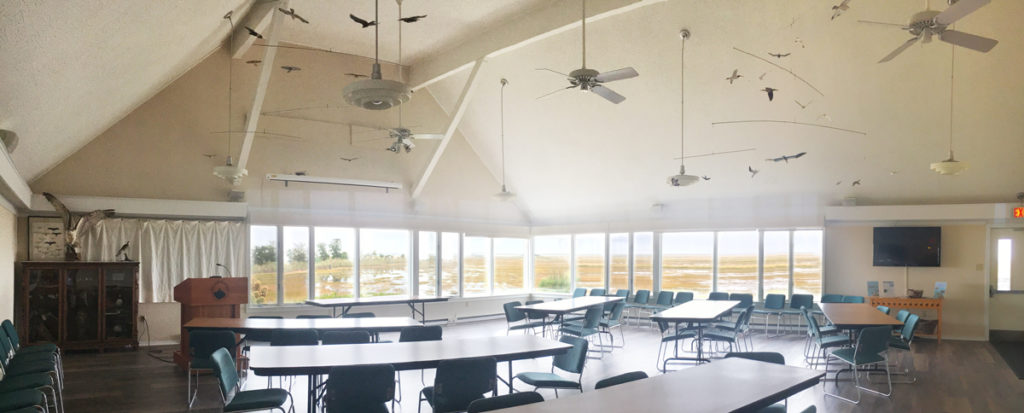
Elevated Marsh Walkway
Plans for a new elevated walkway began after destruction of the old wooden walkway during Hurricane Sandy in October 2012. Reconstruction was an opportunity to rethink the possibilities for the walkway and reposition it for improved access to the marsh for both research and education. Construction was completed over the winter and early spring 2014 and the walkway opened to the public in mid-May. We scheduled winter construction to cause minimum impact to marsh grasses that are dormant through the winter, to avoid disturbance to birds and animals that use the marsh during migration stopovers, and to eliminate impact on nesting Osprey.
The walkway is a 720 foot long loop with an extension for better viewing of the front salt panne. It stands 4 feet above the marsh at its base and is 6 feet wide. Aluminum railings line the elevated walkway, ramps, and stairways for safety. Two sets of stairs allow restricted access for Institute personnel leading research and education programs. Research and education stations provide improved access to the marsh for biological and environmental sampling and hands-on learning opportunities. During Institute business hours, the walkway can be accessed by ADA compliant ramps at two locations from the Institute’s shelled nature trail.
The walkway design and construction were carefully conceived to provide access to the marsh for visitors to learn about the wetlands without impacting the fragile ecosystem. It was also designed to be more resilient to storms and rising sea level – two important considerations. It is sustainably constructed using state-of-the-art methods, and utilized local contractors and locally sourced material to the extent possible. The walkway employs a steel helical pile construction. Piles were cork-screwed into the marsh and extended on average 30 feet below the marsh surface until they reached a lower compact sand layer.
The main walkway structure was locally fabricated and is aluminum. Its grated surface is polycarbonate and is specially designed to allow sunlight and rainwater to reach the plants and animals below and reduce the overall impact to the marsh. Since water can flow through this surface, the walkway has a better chance at surviving major flooding events and storms. Because the entire structure is metal with polycarbonate, there is no lift associated with flooding, making likelihood of damage during rising water levels in storms less. If ever necessary, the entire structure can be recycled.
All work on the marsh required the use of matting to distribute the weight of heavy equipment and prevent rutting. Decking was installed in 40 foot prefabricated sections to increase the speed of installation and decrease time on the marsh. Nearly 90 – 2 7/8” helical steel pilings were installed for a small footprint and strong hold in the marsh. Surveys and boring tests of the marsh were conducted in advance to determine piling locations and elevations.
The costs of the new walkway were covered in part by a FEMA Disaster grant following the destruction of our previous walkway during Hurricane Sandy in October 2012. Remaining costs were funded through donations.
All necessary permits were obtained and all conditions of the permits were met. Pilings were in place before March 15, as a condition of NJDEP permits. The old boardwalk was removed in early 2014, also as per permit.
Contractors (NJ based, and all in 2 county area): Titan Shoring and Construction (construction), Dixon and Associates (engineering), Blue Water Welding (fabrication), The Lomax Consulting Group (environmental review and compliance).
Salt Marsh Trail
Dock
In October of 2012, Hurricane Sandy’s wrath took aim on our region and put a damper on programing at The Wetlands Institute by destroying our dock. Deprived of much needed access to Scotch Bonnet Creek, we had to cancel some of our summer activities including back-bay boating tours on the Skimmer, hooked on fishing, and crabbing at the dock. But with much determination, we managed to revise our programming and have a very successful season.
Our back-bay kayak tours were launched from alternate locations. We even made do with the low tide which left us little access to water during our Crabulous Crab Day. Our visitors enjoyed a full schedule of programs but it wasn’t quite the same. We were missing an integral part of our facility.
Another significant challenge brought on by the loss of our dock was the loss of our salt water pumping system. This system was used to pump water along the quarter-mile long Salt Marsh Trail to maintain our aquarium. Losing this system meant having to haul water by truck in a 500 gallon tank every week.
The new dock was officially opened to the public in September 2013, during our 1st Annual Fall Migration Festival. And it was well worth the wait! The 122 foot long structure is higher and is constructed of all new non-polluting materials. Its railing system has two heights providing safe and great views for kids. We have boat slips for our 2 research boats and an area for the Skimmer to dock. Gates provide access to water monitoring research equipment that will be installed in the spring. A new submerged pump has the pumping facility back on line.
The rebuilding was made possible through your generosity. We couldn’t have done it without all your support and we are thrilled to be back in business and better than before. The McLean Contributionship supported the project with a $15,000 grant and contributions to The Wetlands Institute’s Sandy Rebuilding Fund raised more than $40,000. The remaining funds came from a Federal Emergency Management Agency disaster assistance grant.
Although it made for a challenging year, the setback brought by Sandy did not affect our motivation to keep moving forward. Our rebuilding efforts continued, and we completed construction on a new and expanded elevated loop boardwalk to replace the damaged walkway.


